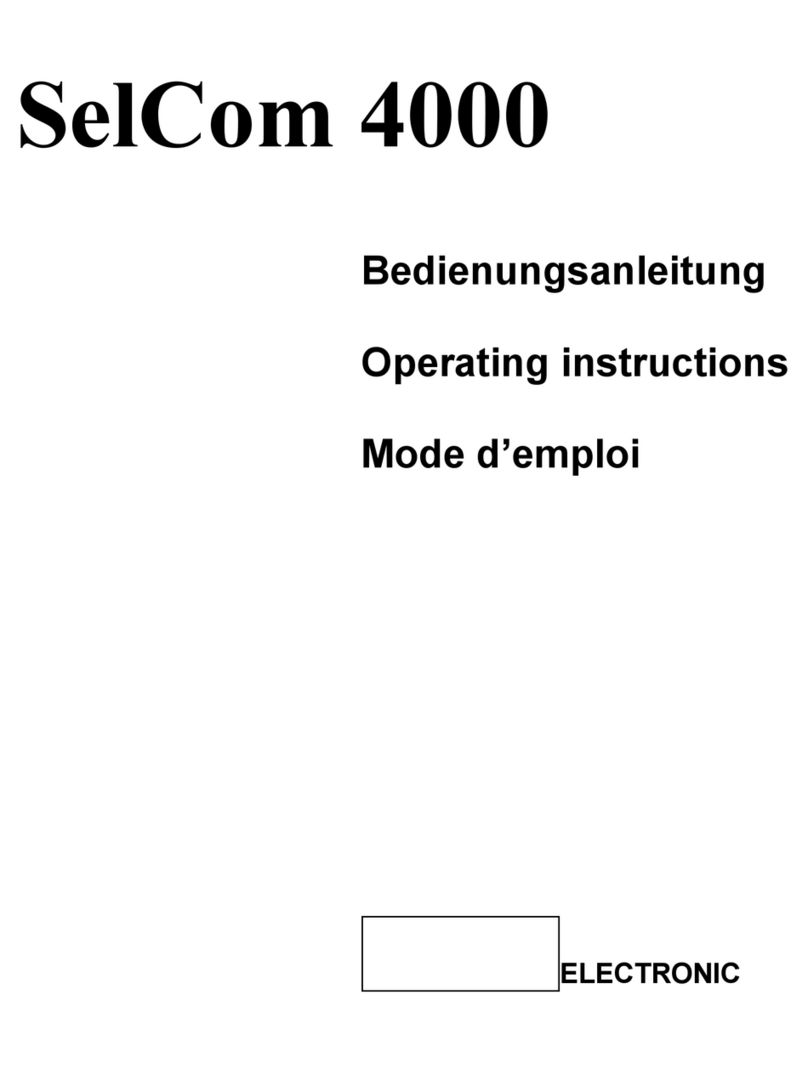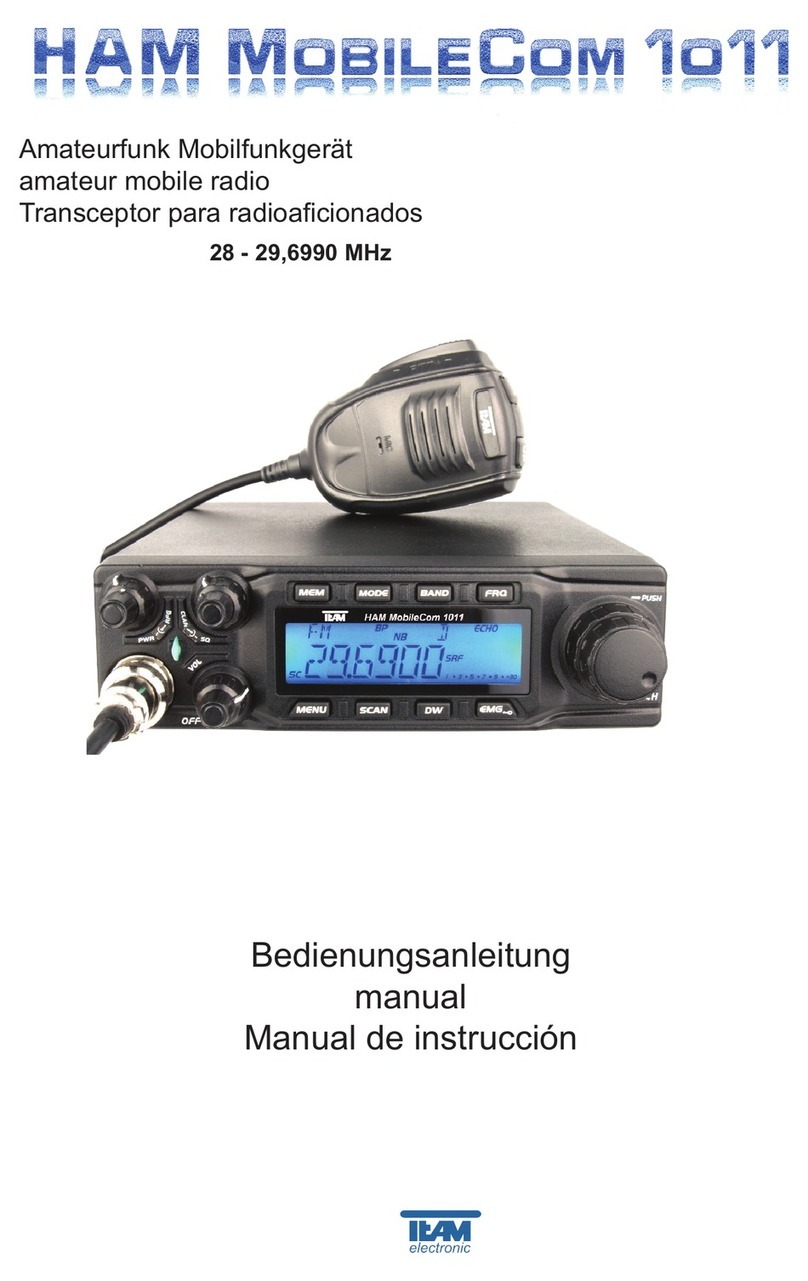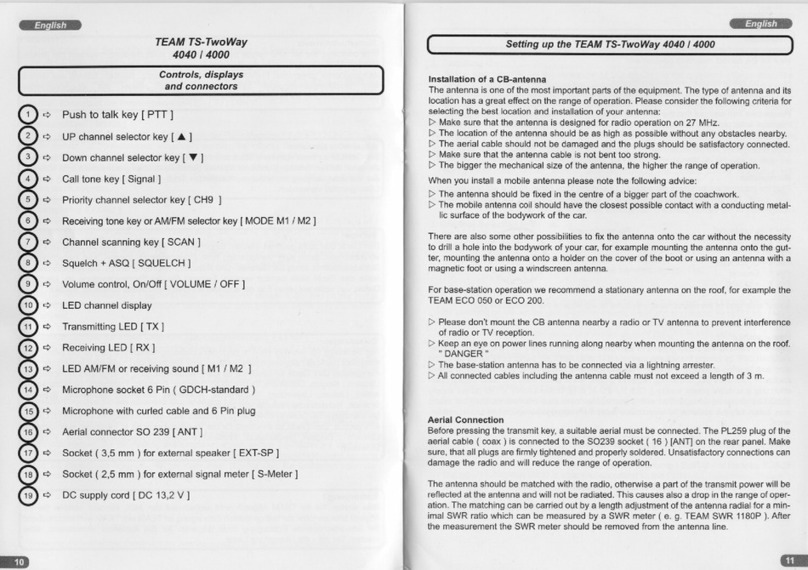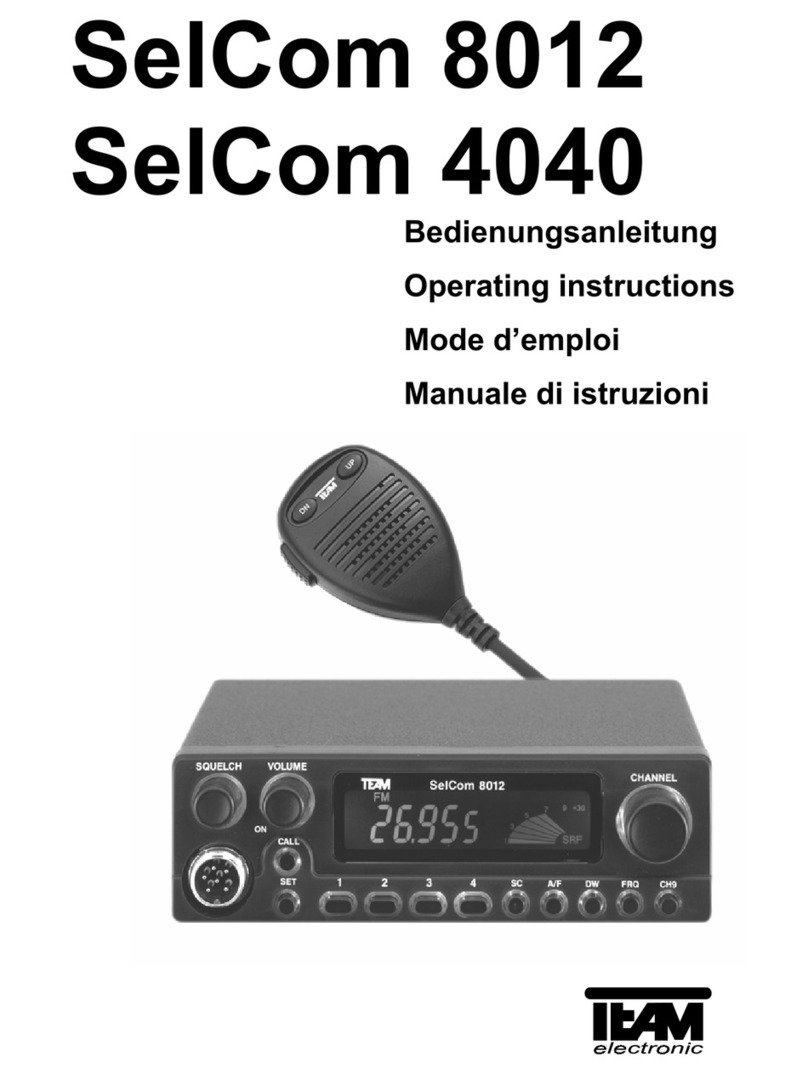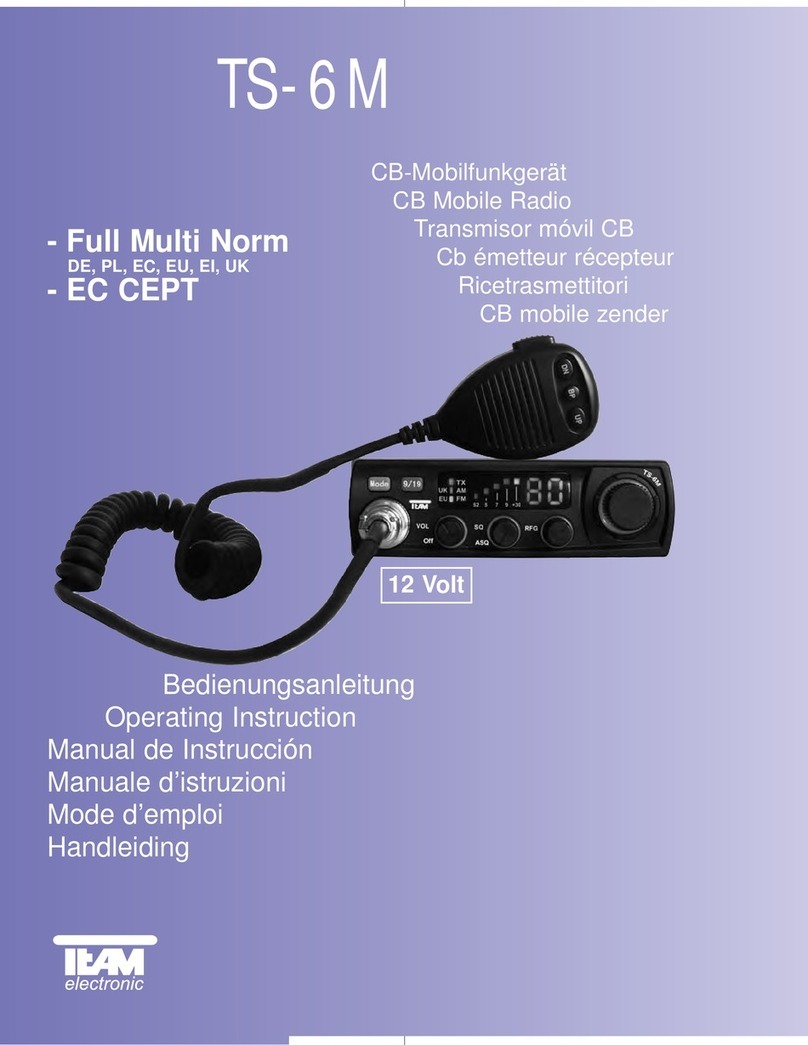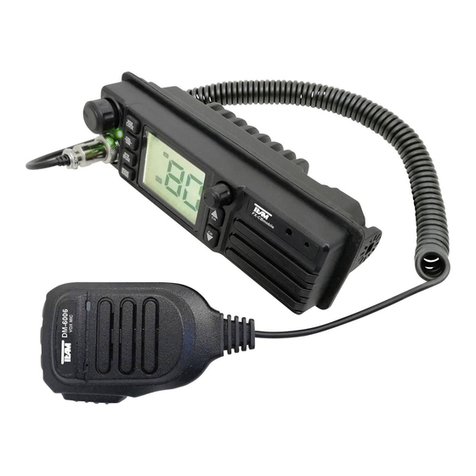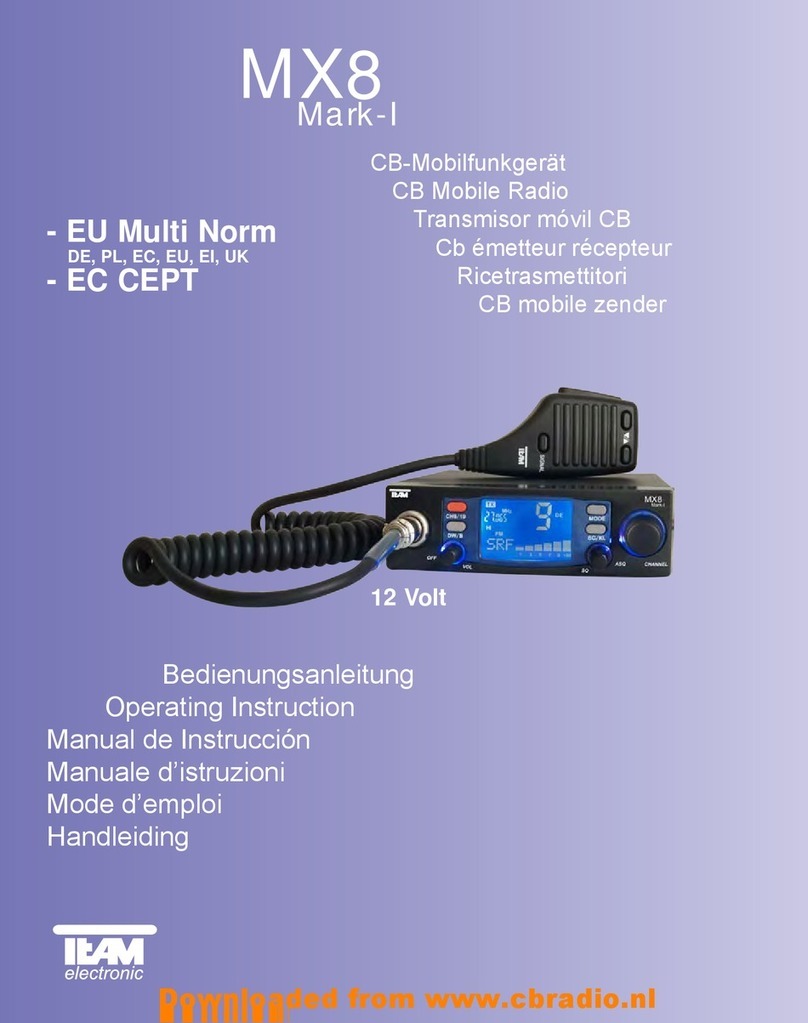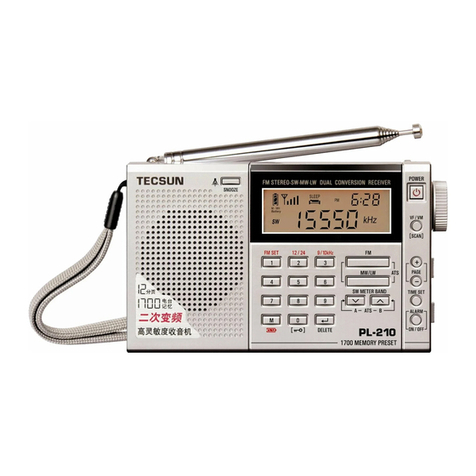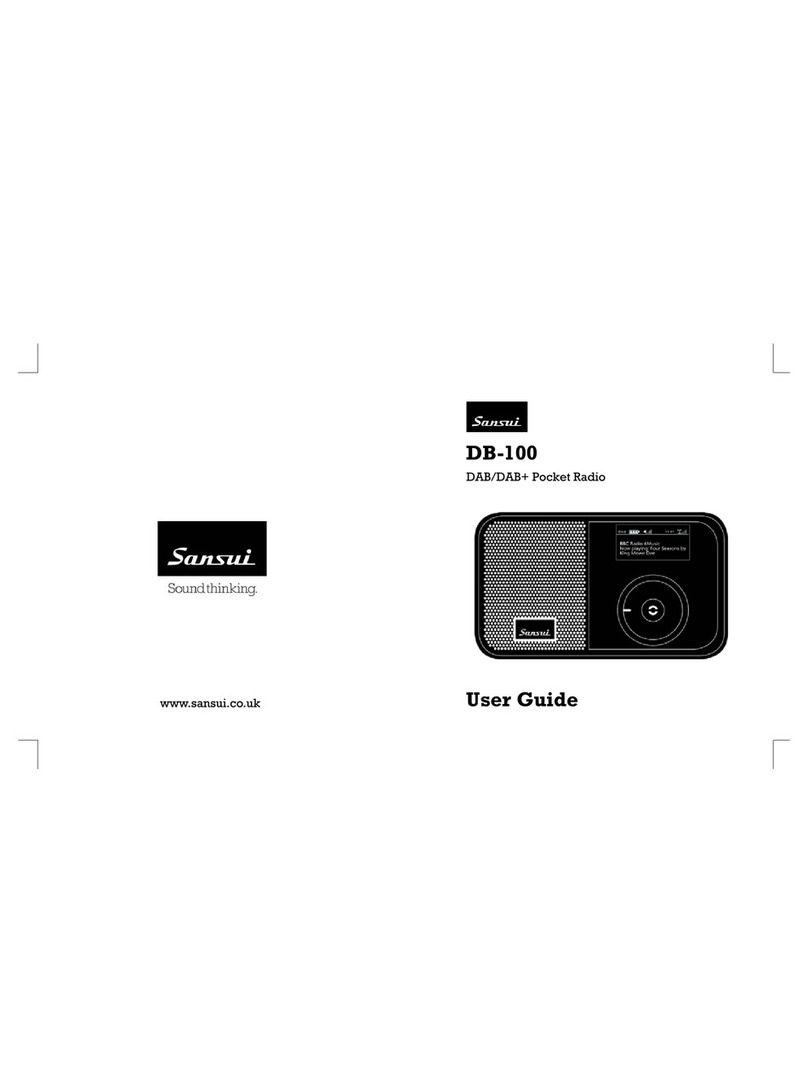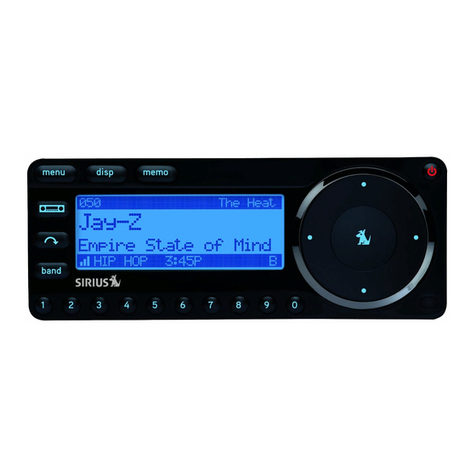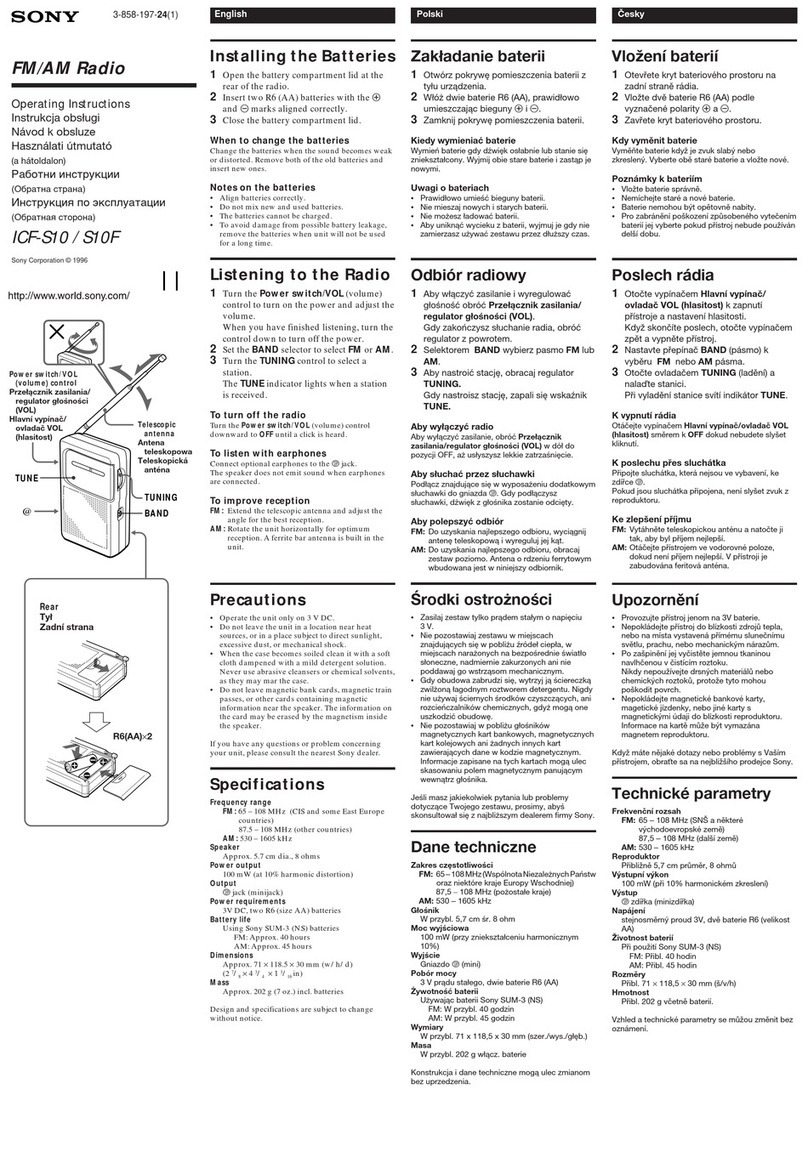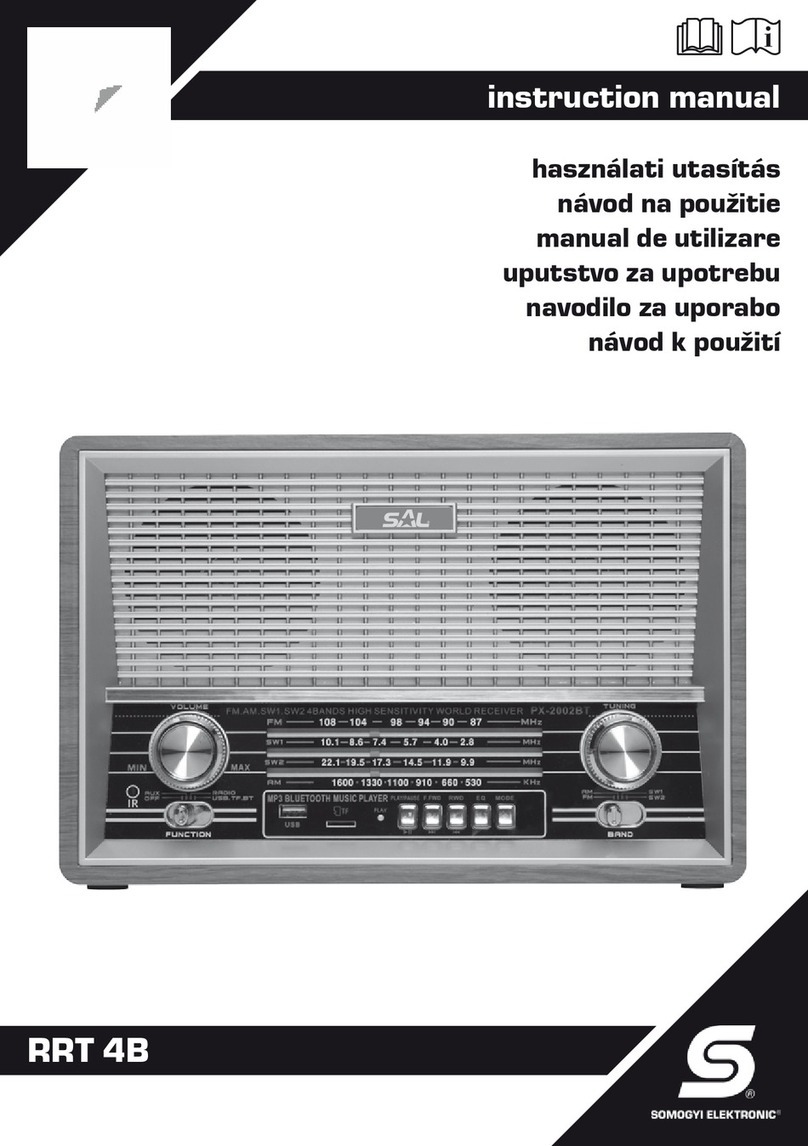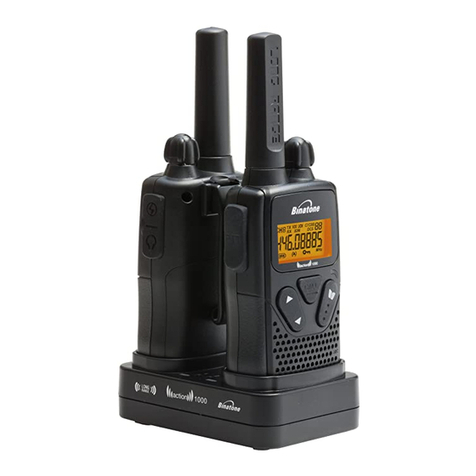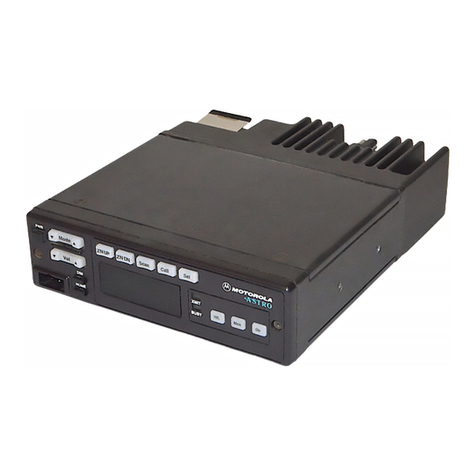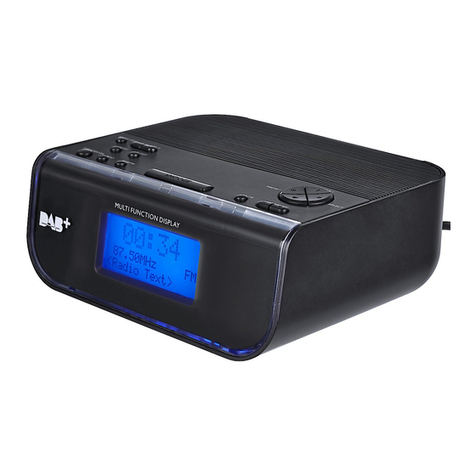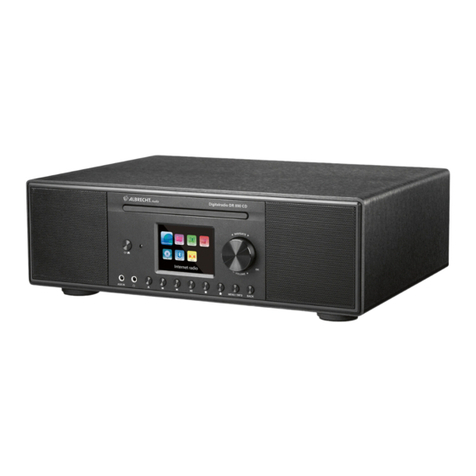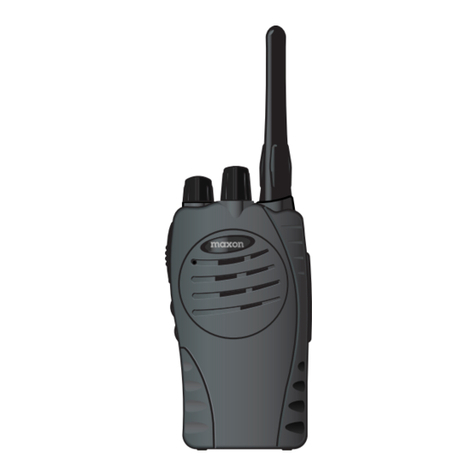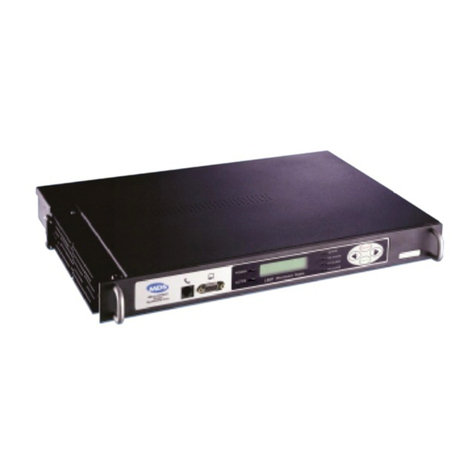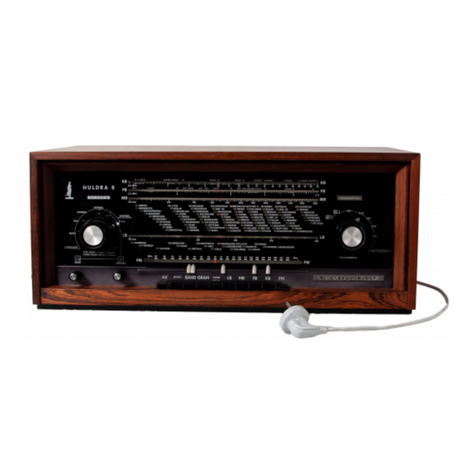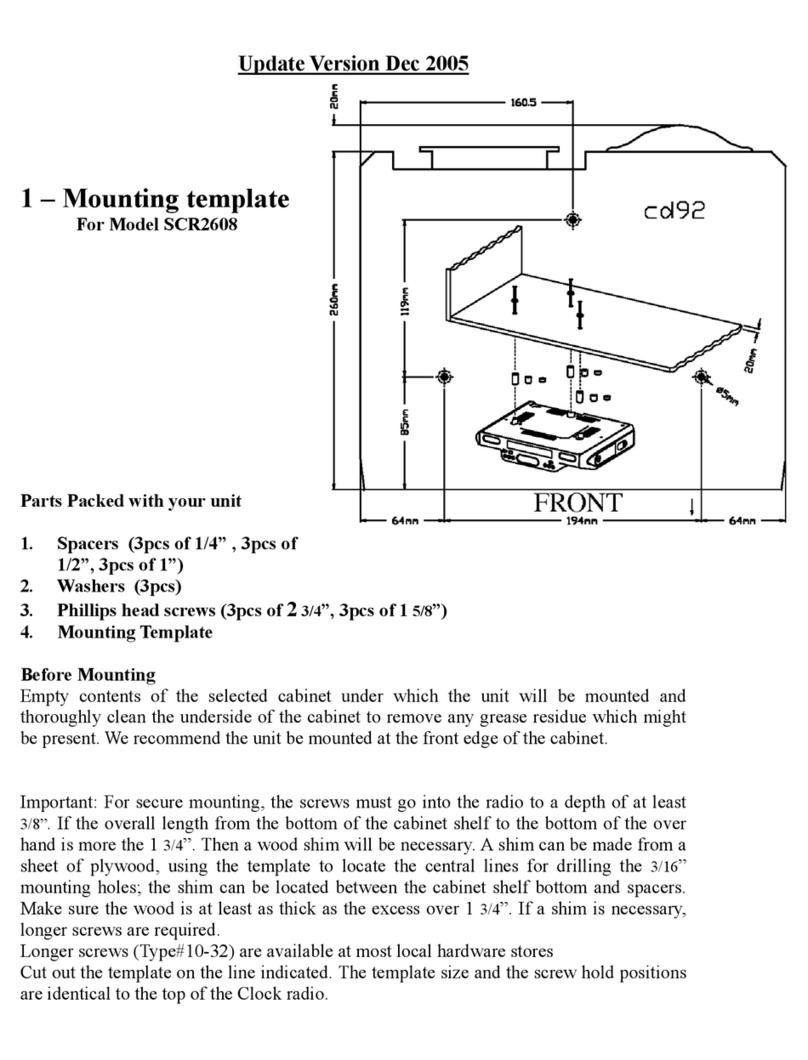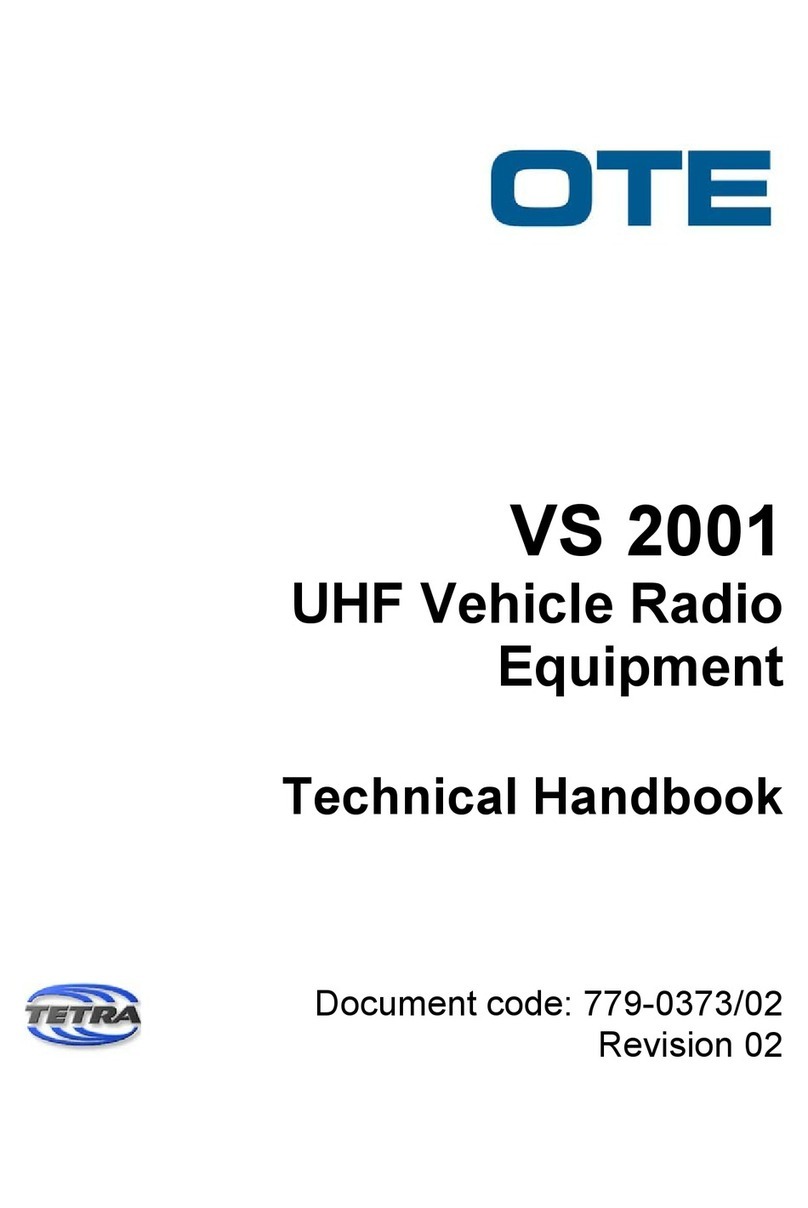Team RoadCom-FS User manual

RoadCom-FS
Bedienungsanleitung
Operating Instruction
Manual de Instrucción
Manuale d’istruzioni
Mode d’emploi
Handleiding
Full Multi Norm / c / df
roadcom-FS-FMN_manual_09052012_V1_mod:RoadCOM manual.qxd 24.05.2012 13:18 Seite 1

1 Micrófono con cable rizado y
conector 6 pin
2 Botón de selector canal/ Arriba [ p]
3 Botón selector canal/ Abajo [ q]
4 Botón pulsar para hablar [ PTT ]
5 Botón tono de llamada [ SIGNAL ]
6 Indicador LCD
7 Control de volumen,
Encendido/Apagado [ Vol / Off ]
8 Interruptor de Squelch + Squelch
automático [SQ/Asq ]
9 Interruptor selector rotativo de
canal [ Channel ]
10 Conector de micrófono 6 pin
( GDCH estándar)
11 CTCSS
12 Interruptor de palanca de
modulación [ Mode]
13 Interruptor Encendido /Apagado
función VOX
14 Posición de espera (Standby) LED
de la función VOX [ VOX ]
15 Botón de exploración de canal [
Scan ]
16 Botón selector de iluminación de
fondo LCD [ B ]
17 Botón repetición de marcación de
último canal [ LCR ]
18 Botón de conmutador de sonido
Audio [ Hi / Lo ]
19 Doble escucha o botón de bloqueo
[ Dual Watch / ]
20 Botón de prioridad canal 9 [ CH9 ]
21 Conector de antena aéreo SO239
22 Conector de alimentación DC
23 Conector Jack ( 3,5 mm ) para
altavoces externos
24 Conector Jack ( 2,5 mm ) para
S-Meter externo
Español página 23 - 31
Netherland pagina 54 - 62
1 Microfoon met spiraal kabel
en 6 pin plug
2 Kanaal selectie omhoog [ p]
3 Kanaal selectie omlaag [ q]
4 Push to talk toets [ PTT ]
5 Oproeptoon toets [ SIGNAL ]
6 LC display
7 Volume bediening, Aan/Uit
schakelaar [ Vol / Off ]
8 Squelch bediening + automa!
tische squelch [ SQ/Asq ]
9 Draai schakelaar voor de
kanalen [ Channel ]
10 Microfoon aansluiting 6 pin
( GDCH standaard )
11 CTCSS
12 AM/FM schakelaar [ Mode ]
13 VOX functie aan/uit schakelaar
14 Standby LED van de VOX
functie [ VOX ]
15 Toets voor scannen van de
kanalen [ Scan ]
16 Keuze toets voor LCD
achtergrond verlichting [ B]
17 Last channel recall toets [ LCR ]
18 Toets voor de omschakeling
van de toon [ Hi / Lo ]
19 Dual Watch of toetsen
blokkering [ Dual Watch / ]
20 Kanaal 9 priority toets [ CH9 ]
21 Antenne aansluiting SO239
22 DC voeding connector
23 Jack aansluiting ( 3.5 mm )
voor externe luidspreker
24 Jack aansluiting ( 2.5 mm )
voor externe Signaal meter
1 Mikrofon mit Spiralkabel +
6-Pol Stecker
2 Kanalwahltaste Aufwärts [ p]
3 Kanalwahltaste Abwärts [ q]
4 Sendetaste [ PTT ]
5 Rufsignaltaste [ SIGNAL ]
6 LCD-Anzeige
7 Lautstärkeregler / Ausschalter
[ Vol / Off ]
8 Rauschsperreregler und
auto. Rauschsperre [ SQ/Asq ]
9 Kanaldrehwahlschalter [ Channel ]
10 Mikrofonanschlussbuchse
6polig,GDCH-Norm
11 CTCSS
12 Modulation [ Mode ]
13 Sprachsteuerungsfunktion
14 Sprachsteuerungsfunktion-LED
[ VOX ]
15 Kanalsuchlauftaste [ Scan ]
16 Hintergrundbeleuchtung [ B ]
17 Wiederaufruf des letzten Kanals
[ LCR ]
18 Empfangston [ Hi / Lo ]
19 Zweikanalüberwachung oder
Tastatursperre [ Dual Watch / ]
20 Vorrangkanaltaste für Kanal 9/19
[ CH9/19 ]
21. CTCSS-Programmiertaste [ SET ]
22 Antennenanschlussbuchse SO239
23 Stromversorgungsanschlussbuchse
24 Anschlussbuchse für
ext. Lautspr. 3,5 mm
25 Anschlussbuchse für ext.
S-Meter 2,5 mm
Deutsch Seite 4 - 13
6
18 20
11
8
13
14
10 16
17
9
19
12
7
15
1
5
4
2
3
22
23
24
32
21 1 Microfono con cavo
spiralizzato e spina a 6 Pin
2 Tasto selettore canale
UP [ p]
3 Tasto selettore canale
Down [ q]
4 Tasto PTT
5 Tasto segnale chiamata
6 Display LCD
7 Regolazione volume+
interruttore ON/OFF
8 Regolazione Squelch +
Squelch automatico
[ SQ / Asq ]
9 Interruttore a rotazione per
selezione canale [ Channel ]
10 Presa microfono a 6 Pin
( GDCH standard )
11 CTCSS
12 Interruttore selezione
modulazione [ Mode ]
13 Interruttore on/off
funzione VOX
14 LED di standby funzione
VOX [ VOX ]
15 Tasto scansione
canali [ Scan ]
16 Tasto selezione
retroilluminazione LCD [ B ]
17 Tasto richiamata ultimo
canale [ LCR ]
18 Tasto riproduzione
audio[ Hi / Lo ]
19 Dual Watch o tasto blocco
[ Dual Watch / ]
20 Tasto di canale 9
prioritario [ CH9 ]
21 Connettore SO239
22 Connettore alimentatore
23 Jack (3,5 mm.) per
altoparlante esterno
24 Jack (2,5 mm.) per
S-meter esterno
Italiano página 36 - 43
1 Microphone avec câble torsadé
et fiche 6 broches
2 Touche de sélection de canaux
vers le haut [ p]
3 Touche de sélection de canaux
vers le bas [ q]
4 Touche d'émission [ PTT ]
5 Touche de la tonalité [ SIGNAL ]
6 Afficheur du type LCD
7 Réglage du volume et marche /
arrêt [ Vol / Off ]
8 Réglage du squelch et marche /
arrêt du squelch
automatique [ SQ / Asq ]
9 Sélecteur rotatif de canaux [ Channel ]
10 Prise du microphone 6 broches
( standard GDCH )
11 CTCSS
12 Touche de commutation du
fonctionnement AM/FM [ Mode ]
13 Commutateur marche / arrêt
de la fonction VOX
14 Lampe témoin de la disponibilité
de la fonction VOX [ VOX ]
15 Touche de la recherche de canaux [Scan]
16 Touche de sélection de l'éclairage
de l'afficheur LCD [ B]
17 Touche de rappeler le canal dernier [LCR]
18 Touche de commutation du ton
de réception [ Hi / Lo ]
19 Touche de contro de deux
canaux et de la verrouillage
du clavier [ Dual Watch / ]
20 Touche canal 9 prioritaire [ CH9 ]
21 Connecteur d'antenne SO239
22 Prise d'alimentation
23 Prise jack ( 3,5 mm ) pour un
haut-parleur externe
24 Prise jack ( 2.5 mm ) pour un
S-mètre externe
Français page 44- 52
1 Microphone with curled cable
and 6 pin plug
2 Channel selector key Up [ p]
3 Channel selector key
Down [ q]
4 Push to talk key [ PTT ]
5 Call tone key [ SIGNAL ]
6 LC display
7 Volume control, On/Off switch
[ Vol / Off ]
8 Squelch control and automatic
squelch [ SQ / Asq ]
9 Rotary channel selector
switch [ Channel ]
10 Microphone socket 6 pin
8 GDCH standard )
11 CTCSS
12 Modulation toggle
switch [ Mode ]
13 VOX function On/Off switch
14 Standby LED of the
VOX function [ VOX ]
15 Channel scanning key [ Scan ]
16 LCD background illumination
selector key [ B ]
17 Last channel recall key [ LCR ]
18 Audio reproduction sound
toggle key [ Hi / Lo ]
19 Dual Watch or Key lock key
[ Dual Watch / ]
20 Channel 9 priority key [ CH9 ]
21 Aerial connector SO239
22 DC power supply connector
23 Jack socket ( 3.5 mm ) for
external speaker
24 Jack socket ( 2.5 mm ) for
external S-meter
English page 14 - 22
roadcom-FS-FMN_manual_09052012_V1_mod:RoadCOM manual.qxd 24.05.2012 13:18 Seite 2

Deutsch
Inbetriebnahme des TEAM RoadCom-FS
1) Montage einer CB-Funkantenne
Die Wahl der Antenne und des Montageortes ist von großer Bedeutung für die maximale
Reichweite Ihrer Funkanlage. Die folgenden Kriterien sollten Sie bei der Wahl des Anten-
nenstandortes und der Montage berücksichtigen.
Allgemein gilt:
> Die Antenne muss für den Funkbetrieb auf 27 MHz geeignet sein.
> Der Standort der Antenne sollte möglichst hoch und unverbaut sein.
> Das Antennenkabel muss unbeschädigt, und die Stecker ordnungsgemäß angeschlossen
sein.
> Das Antennenkabel darf nicht zu stark geknickt werden.
> Antennen mit einer größeren mechanischen Länge erzielen bessere Reichweiten.
Bei der Montage von Mobilantennen ist folgendes zu beachten:
> Die Antenne sollte in der Mitte eines größeren Karosserieteils montiert werden.
> Der Antennenfuß von Mobilantennen sollte möglichst guten Kontakt zu einer metallisch gut
leitenden Fläche des Karosseriebleches haben.
Außer der "festen Montage" einer Mobilantenne, bei der ein Loch in die Karosserie Ihres Fahr-
zeuges gebohrt werden muss, gibt es noch weitere Möglichkeiten, z. B. die Dachrinnen- oder
Kofferraumdeckel-Montage, sowie die Befestigung mit Magnetfuß oder Scheibenantenne.
2) Antennenanschluss
Der PL-Stecker (Typ PL259) des Antennenkabels (Koaxialkabel) wird mit der Buchse (21) an
der Geräterückseite verbunden. Für eine einwandfreie Verbindung muss der Überwurf des
Steckers gut festgedreht werden. Ebenso ist auf eine ordentliche Verbindung des Antennen-
kabels mit dem Antennenfuß zu achten. Nicht einwandfreie Verbindungen können zu einem
Defekt des Gerätes führen und die Funkreichweite erheblich verringern. Die Antennenanlage
(nicht im Lieferumfang enthalten) sollte sehr gut an das Funkgerät angepasst sein, ansonsten
wird ein Teil der Sendeleistung an der Antenne reflektiert und nicht abgestrahlt. Das führt
ebenfalls zu einer geringeren Reichweite der Funkanlage. Die Anpassung der Antenne erfolgt
durch Längenabgleich des Antennenstrahlers bzw. seiner Anpassungsvorrichtung auf ein
minimales Stehwellenverhältnis, welches mit einem Stehwellenmessgerät (z.B. TEAM SWR
1180 P) gemessen werden kann. Das Stehwellenmessgerät muss nach der Messung wieder
aus der Antennenleitung entfernt werden.
Deutsch
INHALTSVERZEICHNIS
Inbetriebnahme des TEAM RoadCom-FS
1) Montage einer CB-Funkantenne 5
2) Antennenanschluss 5
3) Montage des Gerätes im Fahrzeug 6
4) Mikrofon DM-106S 6
5) Stromversorgung 6 - 7
Funkbetrieb mit dem TEAM RoadCom-FS
1) Einschalten [Vol/Off]7
2) Rauschsperre [SQ/Asq]7
3) Quittungstöne 8
4) Kanalwahl [p] [q]8
5) Empfangstonumschaltung [Hi/Lo]8
6) LCD-Hintergrundbeleuchtung [B] 8
7) Umschaltung der Modulationsarten [Mode]8
8) Umschaltung der Versionen [DE/EC/EI/EU/PL/UK] 9
9) Senden 9
10) Rufsignal 9
11) CTCSS [CTCSS] & [SET] 9 - 10
12) Wiederaufruf des letzten Kanals [LCR]10
13) Vorrangkanal 9/19 [CH9/19] 10
14) Kanalsuchlauf [Scan]10
15) Zweikanalüberwachung [Dual Watch / ]11
16) Tastatursperre [Dual Watch / ]11
17) VOX-Funktion 11 - 12
18) Anschlussbuchse für einen externen Zusatzlautsprecher 12
19) Anschlussbuchse für ein externes Signal-Meter 12
Hinweise
1) Sicherheitshinweis 12
2) Allgemeine Hinweise 13
3) Service 13
4) Konformität 13
5) Entsorgung 13
Schaltplan 32 - 34
Kanalfrequenztabelle 35
Technische Daten 63
4 5
roadcom-FS-FMN_manual_09052012_V1_mod:RoadCOM manual.qxd 24.05.2012 13:18 Seite 4

SCHWARZ wird mit -(= MINUS/Masse) des KFZ verbunden.
ROT wird mit 12/24 Volt +(= PLUS) des KFZ/LKW-Bordnetzes verbunden.
Bei Verwendung von Dauerplus bleiben die letzten Einstellungen auch nach dem Ausschal-
ten des Gerätes und dem Abstellen des Motors gespeichert.
Bei dem Kauf eines Netzteils sollten Sie darauf achten, dass es für den Anschluss eines
Funkgerätes geeignet ist. Bei ungeeigneten Netzteilen kann im Sendebetrieb die Betriebs-
spannung stark ansteigen, und/oder Störungen im Sende- und Empfangsbetrieb durch Netz-
brummen auftreten.
Nachdem die Antenne, das Mikrofon und die Stromversorgung sorgfältig angeschlossen sind,
kann der Funkbetrieb aufgenommen werden.
Funkbetrieb mit dem TEAM RoadCom-FS
1) Einschalten [Vol/Off]
Vor dem erstmaligen Einschalten sollte der Rauschsperreregler (8) [SQ/Asq] bis zum Linksan-
schlag gedreht werden, aber ohne ihn einzurasten. Das Gerät wird eingeschaltet, indem Sie den
Lautstärkeregler (7) [Vol/Off] nach rechts drehen. Das Gerät befindet sich beim erstmaligen Ein-
schalten nach einer Unterbrechung der Spannungszufuhr auf Kanal 9 in der Betriebsart FM. Der
Hintergrund der Anzeige leuchtet nun orange oder blau auf und das Empfängerrauschen oder
eine andere Station wird hörbar. Stellen Sie die gewünschte Lautstärke ein.
Alle Einstellungen, die beim Betrieb des Gerätes vorgenommen werden, bleiben nach dem
Ausschalten erhalten, solange die Stromversorgung nicht unterbrochen wird.
2) Rauschsperre [SQ/Asq]
Das störende Rauschen, das immer auf freien Kanälen auftritt, kann durch Rechtsdrehen des
Rauschsperrereglers (8) [SQ/Asq] unterdrückt werden. Der Regler sollte nur soweit über den
Stummschaltepunkt gedreht werden, bis das Rauschen sicher unterdrückt ist. Wenn eine Sta-
tion auf dem Kanal ist, öffnet der Squelch, und man kann sie hören. Bei zu kritischer Einstel-
lung der Rauschsperre kann ein kurzes Rauschen ab und zu auftreten, ohne dass sich eine Sta-
tion auf dem Kanal befindet. Weiteres Rechtsdrehen unterdrückt zunehmend schwache Statio-
nen, aber auch stärkere Störsignale. Bei einer zu festen Squelcheinstellung kann es bei SCAN-
Betrieb zur Nichterkennung eines belegten Kanals kommen. Durch Drehen nach links, über die
Schalterschwelle hinaus, wird die Automatikstellung [Asq] gewählt. Der Squelchschaltpunkt ist
dann intern auf einen festen erprobten Wert eingestellt.
3) Montage des Gerätes im Fahrzeug
Das Gerät kann entweder mit dem beiliegenden Montagebügel unter dem Armaturenbrett
befestigt werden oder in einen Autoradio-Schacht mit Hilfe des ebenfalls beiliegenden Ein-
baurahmens eingesetzt werden. Bei der Wahl der optimalen Position für die Montage des
Gerätes in Ihrem Fahrzeug sind auch die folgenden Kriterien zu berücksichtigen:
> keine Beeinträchtigung der Verkehrssicherheit,
> gute Erreichbarkeit der Bedienelemente,
> ausreichende Luftzirkulation, um eine Überhitzung des Gerätes im Sendefall zu verhindern.
Darüber hinaus sollten Sie auch sicherstellen, dass die LCD-Kanalanzeige (6) gut ablesbar
ist. Bei direkter Sonneneinstrahlung kann die Lesbarkeit der Anzeige beeinträchtigt werden.
Die günstigste Montageposition sollte vor dem endgültigen Einbau überprüft werden. Mit Hilfe
des beiliegenden Montagebügels, ist eine schnelle Montage bzw. Demontage an verschiede-
nen Stellen im Fahrzeug möglich.
4) Mikrofon DM-106S
Das Mikrofon (1) wird mit dem 6-poligen Stecker in die Mikrofonbuchse (10) an der linken
Gerätefrontseite angeschlossen. Ohne Mikrofon ist kein Sende- oder Empfangsbetrieb mög-
lich. Die Mikrofonbuchse ist nach GDCH-Standard angeschlossen:
PIN 1 Modulation
PIN 2 Lautsprecher
PIN 3 PTT
PIN 4 Up/Down
PIN 5 Masse
PIN 6 +12 Volt
Ansicht von der Lötseite der Mikrofonbuchse bzw. Vorderansicht des Mikrofonsteckers
Mit dem RoadCom-FS wird das Standardmikrofon DM-106S mit Kanalwahl und Rufsignal
mitgeliefert. Dieses Mikrofon ist optimal für das RoadCom-FS geeignet. Wenn Sie dennoch
ein anderes Mikrofon als das DM-106S verwenden wollen, müssen Sie sicherstellen, dass
die Sprechkapsel auch bei losgelassener PTT-Taste mit dem Funkgerät verbunden bleibt.
Andernfalls kann die VOX-Funktion des RoadCom-FS (Sprachsteuerung des Senders) nicht
arbeiten.
5) Stromversorgung
Vor dem Anschluss der Stromversorgung schalten Sie das Gerät aus, indem Sie den Laut-
stärkeregler (7) [Vol/Off] bis zum Einrasten nach links drehen. Schließen Sie dann den Stek-
ker des mitgelieferten und abgesicherten 2poligen Stromversorgungskabels sorgfältig an die
Buchse (22) auf der Rückseite des Gerätes an. Zum Schutz gegen Verpolung ist der Stecker
so geformt, dass er sich nur auf eine bestimmte Weise in die Buchse einführen lässt.
Anschließend verbinden Sie die beiden blanken Anschlüsse am anderen Ende des Kabels
mit dem Bordnetz Ihres Fahrzeuges. Die Betriebsspannung kann 12 V oder 24 V sein. Das
Stromversorgungskabel sollte möglichst weit von störenden Aggregaten verlegt werden. Ach-
ten Sie beim Anschluss auf die richtige Polarität:
Deutsch Deutsch
6 7
roadcom-FS-FMN_manual_09052012_V1_mod:RoadCOM manual.qxd 24.05.2012 13:18 Seite 6

3) Quittungstöne
Im Empfangsbetrieb werden Eingaben über die Tasten außer der Sprachsteuerungs-Taste
(13) (= Vox-Taste), der Sendetaste (4) [PTT], der Rufsignaltaste (5) [SIGNAL] und dem
Kanalwahldrehschalter (9) [Channel], mit einem kurzen Ton quittiert. Sie können diese
Bestätigungstöne abschalten, indem Sie die Kanalsuchlauftaste (15) [Scan] für ca. 2-3
Sekunden gedrückt halten, bis ein zweiter Quittungston ertönt. Nun werden die Tastenbetäti-
gungen nicht mehr mit einem kurzen Ton quittiert.
In gleicher Weise können die Quittungstöne wieder eingeschaltet werden.
4) Kanalwahl [p] [q]
Die Kanäle können durch Drücken der Kanalwahltasten (2) [p] und (3) [q] am Mikrofon oder
mit dem Kanalwahldrehschalter (9) [Channel] eingestellt werden. Im LC-Display (6) erfolgt die
Anzeige des Kanals mit den großen Ziffern und dessen zugehörige Frequenz mit den kleinen
Ziffern unmittelbar darunter. Während des Sendens kann kein anderer Kanal eingestellt wer-
den. Die Kanalnummern werden wie ein Ring durchlaufen, so dass die Kanäle abwärts zäh-
lend von 1 auf 40 bzw. 80, und aufwärts zählend von 80 bzw. 40 auf 1 übergangslos gewählt
werden können. Es kann nur auf übereinstimmenden Kanalnummern und Modulationsarten
mit der Gegenstation Funkbetrieb aufgenommen werden.
5) Empfangstonumschaltung [Hi/Lo]
Das Gerät verfügt über eine Empfangstonumschaltung (18) [Hi/Lo]. Beim erstmaligen Ein-
schalten nach einer Unterbrechung der Spannungszufuhr ist immer die dunkle Empfangston-
wiedergabe eingestellt und wird mit der LCD-Anzeige (6) mit dem Symbol LO angezeigt. Zum
Umschalten für eine hellere Empfangstonwiedergabe drücken Sie die Taste (18) [Hi/Lo]. Die
Einstellung des hellen Empfangstons wird mit dem Symbol HI angezeigt. In gleicher Weise
kann man den Empfangston auch wieder auf dunkel (Symbol LO) umschalten.
6) LCD-Hintergrundbeleuchtung [B]
Beim erstmaligen Einschalten nach einer Unterbrechung der Spannungszufuhr leuchtet die
Hintergrundbeleuchtung der LCD-Anzeige (6) immer. Die Hintergrundbeleuchtung kann man
durch kurzes Drücken auf die Taste (16) [B] zwischen orange und blau hin- und herschalten.
Bei längerem Drücken für ca. 2-3 Sekunden auf diese Taste schaltet sich die Hintergrundbe-
leuchtung der Anzeige ganz ab. In gleicher Weise kann man die Hintergrundbeleuchtung
auch wieder einschalten.
7) Umschaltung der Modulationsarten [Mode]
Das RoadCom-FS arbeitet in den Modulationsarten AM und FM. Für einige Versionen, z.B.
RoadCom-FS c steht nur die Betriebsart FM zur Verfügung. Beim Einschalten ist stets Kanal
9 und die Betriebsart FM eingestellt, die in der Anzeige (6) mit dem Symbol FM angezeigt
wird. Falls das Gerät auf dem aktuellen Kanal auch die Betriebsart AM akzeptiert, können Sie
es durch Drücken der Taste (12) [Mode] zwischen AM und FM hin- und herschalten. Die
Betriebsart AM wird mit dem Symbol AM angezeigt. Falls das RoadCom-FS die Betriebsart
AM nicht akzeptiert, ertönt nur ein Quittungston, aber das Symbol FM bleibt in der Anzeige.
Falls Sie sich auf einem Kanal in der Betriebsart AM befinden und auf einen Kanal wechseln,
auf dem die Betriebsart AM nicht akzeptiert wird, erfolgt eine Zwangsumschaltung auf FM.
Bei einem weiteren Wechsel auf einen Kanal, auf dem die Betriebsart AM wieder akzeptiert
wird, springt die Betriebsart automatisch wieder auf AM zurück.
8) Umschaltung der Versionen [DE/EC/EI/EU/PL/UK]
Die Ausführung RoadCom-FS Multi Norm kann vom Benutzer auf eine der sechs Versionen
DE/EC/EI/EU/PL/UK eingestellt werden.
Zum Einstellen bzw. Umschalten der Normen halten Sie bitte die Vorrangskanaltaste (20)
[CH9/19] während dem Einschalten des Gerätes gedrückt. In der Anzeige erscheint blinkend
die Ziffer (1-6) der aktuellen Norm. Alle anderen Symbole sind nicht sichtbar. Die gewünsch-
te Norm wird durch Drücken der Vorrangskanaltaste (20) eingestellt. Zum Bestätigen der
Norm, das Gerät kurz aus- und wieder einschalten.
Anzeige/Norm Kanäle, Frequenzen, Sendeleistung
1DE 80 FM (26,565-27,405 MHz), 4 W / 40 AM (26,965-27,405 MHz), 4 W
2EI 40 FM (26,965-27,405 MHz), 4 W / 40 AM (26,965-27,405 MHz), 4 W
3EC 40 FM (26,965-27,405 MHz), 4 W
4EU 40 FM (26,965-27,405 MHz), 4 W / 40 AM (26,965-27,405 MHz), 1 W
5UK 40 FM (27,60125-27,99125 MHz), 4 W / 40 FM (26,965-27,405 MHz), 4 W
6PL 40 FM (26,960-27,400 MHz), 4 W / 40 AM (26,960-27,400 MHz), 4 W
Für die Erlaubnis und die Auflagen zum Betrieb der verschiedenen Normen in den einzelnen
Ländern sehen Sie in den Gerätepass. Der Benutzer ist für die richtige Einstellung der
gültigen Norm im jeweiligen Land eigenverantwortlich.
Hinweise:
Die Ausführung RoadCom-FS -c (EC CEPT) ist intern fest auf 40 Kanäle FM, 4 Watt einge-
stellt und somit für den Betrieb in Österreich geeignet.
Die Ausführung RoadCom-FS -df (EC CEPT) ist intern fest auf 43 Kanäle FM, 4 Watt / 40
Kanäle AM, 1 Watt eingestellt. Diese Gerätevariante ist nur in den Niederlanden zugelassen.
9) Senden
Zum Senden wird die im Mikrofon (1) eingebaute Sendetaste (4) [PTT] gedrückt und für die
Dauer der Durchsage gehalten. Das Sendekontrollsymbol in der LCD-Anzeige TX erscheint.
Die Balkenanzeige unten in der LCD-Anzeige zeigt die relative Sendeleistung an. Das Mikro-
fon sollte aus ca. 5 cm Entfernung mit normaler Lautstärke besprochen werden. Zu lautes
oder zu leises Besprechen erschwert die Verständigung. Nach Beendigung der Durchsage
muss die Sprechtaste (4) sofort wieder losgelassen werden, und das Gerät schaltet auf Emp-
fangsbetrieb zurück.
Während des Sendens sind die meisten Bedienelemente gesperrt, außer der Sprachsteue-
rungs-Taste (13) (= Vox-Taste) und der Rufsignaltaste (5) [SIGNAL].
10) Rufsignal
Werden am Mikrofon (1) die PTT-Taste (4) und die Rufsignaltaste (5) [SIGNAL] gleichzeitig
gedrückt, wird ein Rufsignal ausgesendet. Dieses ist nur in der Gegenstation zu hören, vor-
ausgesetzt diese ist auf gleichen Kanal und gleiche Betriebsart eingestellt.
11) CTCSS [CTCSS] & [SET]
Die Funktion CTCSS (Continuous Tone Coded Squelch System) erlaubt die gezielte Auswahl
bestimmter Funkgeräte auf einer Funkfrequenz in der Betriebsart FM. Bei Senden wird gleich-
zeitig ein tiefer Ton, der CTCSS-Kode (67 -300 Hz), übertragen. Dieser Ton kontrolliert die
Rauschsperre (Squelch) des Empfängers. Nur wenn die CTCSS-Kodierungen von Sender und
Empfänger übereinstimmen, öffnet die Rauschsperre des Empfängers und das Signal ist zu hören.
DeutschDeutsch
8 9
roadcom-FS-FMN_manual_09052012_V1_mod:RoadCOM manual.qxd 24.05.2012 13:18 Seite 8

15) Zweikanalüberwachung [ Dual Watch / ]
Mit dieser Funktion können Sie zwei Kanäle unabhängig voneinander überwachen. Damit diese
Funktion ordnungsgemäß arbeiten kann, muß die Rauschsperre wie unter Abschnitt 2beschrie-
ben eingestellt werden. Wählen Sie zunächst den ersten Überwachungskanal aus mit dem
Kanaldrehwahlschalter (9) [Channel] oder den Kanalwahltasten (2) [p] und (3) [q] am Mikrofon
mit seiner Modulationsart. Drücken Sie kurz die Taste (19) [Dual Watch / ], so dass das Sym-
bol für die Zweikanalüberwachung DW blinkend in der Anzeige erscheint. Wählen Sie dann
mittels des Kanaldrehwahlschalters (9) oder der Kanalwahltasten (2) und (3) am Mikrofon den
zweiten Überwachungskanal mit ggf. anderer Modulationsart aus. Drücken Sie dann erneut
kurz die Taste (19) [Dual Watch / ], so dass das Symbol für die Zweikanalüberwachung DW
nun dauerhaft in der Anzeige erscheint. Die Zweikanalüberwachung ist nun endgültig aktiviert.
Der zweite Druck auf die Taste (19) [Dual Watch / ] muss innerhalb von 23 Sekunden nach
dem ersten Druck auf diese Taste passieren, sonst erfolgt ein Abbruch der Zweikanalüberwa-
chung, was sich durch Erlöschen des Symbols DW bemerkbar macht.
Das Gerät springt nun zweimal pro Sekunde zwischen den beiden Überwachungskanälen hin
und her, solange keiner der beiden belegt ist. Wenn ein Kanal belegt ist, was sich durch Öffnen
der Rauschsperre äußert, bleibt das Gerät solange darauf stehen, bis die Rauschsperre wieder
schließt. 7 Sekunden später springt das Gerät wieder zwischen den beiden Kanälen hin und her.
Wenn Sie die Taste (19) [Dual Watch / ] noch einmal kurz drücken, so erscheint das Sym-
bol für die Zweikanalüberwachung DW wieder blinkend, und Sie können mittels des Kanal-
drehwahlschalters (9) oder der Kanalwahltasten (2) und (3) am Mikrofon einen neuen zwei-
ten Überwachungskanal auswählen mit neuer Modulationsart. Der Kanal, der beim erneuten
Drücken der Taste (19) [Dual Watch / ] aktuell war, ist nunmehr der erste Überwachungs-
kanal.
Um die Zweikanalüberwachung zu beenden, drücken Sie zweimal kurz hintereinander die Taste
(19) [ Dual Watch / ], einmal irgendeine andere Funktionstaste auf der Gerätevorderseite,
außer der für die VOX-Funktion, eine Kanalwahltaste, oder drehen Sie am Kanaldrehwahl-
schalter (9) [Channel]. Als Zeichen für die Beendigung der Funktion verschwindet das Symbol
DW daraufhin von der Anzeige.
Senden auf dem aktuellen Kanal ist möglich, beendet die Zweikanalüberwachung jedoch nicht.
16) Tastatursperre
Wenn Sie die Taste zur Aktivierung der Zweikanalüberwachung oder der Tastatursperre (19)
[ Dual Watch / ] für längere Zeit gedrückt halten, ertönt nach 2 Sekunden ein zweiter kur-
zer Quittungston, der die Aktivierung der Tastatursperre ankündigt. Zur Anzeige der Tastatur-
sperre erscheint in der Anzeige auch das Schlüsselsymbol . In diesem Zustand reagiert
das Gerät weder auf die Funktions- und Kanalwahltasten, noch auf den Kanaldrehwahlschal-
ter (9). Lediglich Senden mit und ohne Rufton und Aktivierung der VOX-Funktion sind mög-
lich. Die Funktion bleibt auch bei zwischenzeitlichem Abschalten des Gerätes erhalten, sofern
die Versorgungsspannung nicht abgetrennt wird. Zum Abschalten hält man erneut die Taste
(19) [ Dual Watch / ] länger gedrückt, bis nach 2 Sekunden wiederum ein kurzer Quittungs-
ton ertönt, der die Aufhebung der Tastatursperre ankündigt. Gleichzeitig verschwindet in der
Anzeige das Schlüsselsymbol .
Nun sind die gesperrten Bedienelemente wieder frei.
17) VOX-Funktion
Die VOX-Funktion ist eine durch Sprache gesteuerte Aktivierung des Senders. Das bedeutet,
dass sich das Funkgerät durch Sprechen ins Mikrofon automatisch auf Sendebetrieb
umschaltet, so dass das Drücken der Sendetaste am Mikrofon zur Übermittlung einer Nach-
richt überflüssig wird. Zur Vermeidung von unbeabsichtigtem Senden ist die VOX-Schaltung
Werkseitig ist den FM-Kanälen keine CTCSS-Kodierung zugewiesen. Um dem gewünschten
Kanal eine CTCSS- Kodierung zuzuteilen, folgen Sie bitte den folgenden Schritten:
1. Stellen Sie den FM-Kanal ein, dem ein CTCSS-Kode zugewiesen werden soll.
2. Halten Sie die CTCSS-Taste [CTCSS] gedrückt, bis das CTCSS-Symbol in der Anzeige zu
blinken beginnt.
3. Wählen Sie eine der 39 verfügbaren CTCSS-Kodierungen (0 - 39; 0=keine Kodierung ge-
wählt) mit Hilfe der Set- [SET] oder der CTCSS-Taste [CTCSS].
Achten Sie beim Einstellen der gewünschten CTCSS-Kodierung mit Hilfe der CTCSS-
Taste darauf, die Taste nur kurz zu Drücken, da zu langes Drücken der CTCSS-Taste zum
Beenden des Menüs führt.
4. Zum Bestätigen der gewünschten Einstellung drücken Sie bitte die CTCSS-Taste für ca.
eine Sekunde. Das CTCSS-Symbol hört auf zu Blinken und leuchtet nun beständig.
12) Wiederaufruf des letzten Kanals [LCR]
Durch kurzen Druck auf die Taste (17) [LCR] wird der Kanal und die Modulationsart aufgerufen,
bei denen zuletzt die Sendetaste betätigt wurde. Der aktuelle Kanal und die aktuelle Modu-
lationsart bleiben im Hintergrund gespeichert und werden bei erneutem Druck auf die Taste (17)
[LCR] wieder aufgerufen, sofern kein Wechsel von Kanal und/oder Modulationsart stattfindet.
13) Vorrangkanal 9/19 [CH9/19]
Das Gerät verfügt in allen Versionen über die Vorrangkanäle 9 und 19. Durch einmaliges
Drücken der Vorrangskanaltaste (20) [CH9/19] wird der Kanal 9 eingestellt. Um Kanal 19 als
Vorrangskanal einzustellen, muss die Vorrangskanaltaste zwei Mal gedrückt werden.
Wenn der Vorrangkanal aktiviert worden ist, wird seine Kanalnummer und -frequenz blinkend
im Display angezeigt, und der Kanaldrehwahlschalter, sowie alle Funktionstasten, außer
denen für Senden, Rufsignal und VOX-Funktion sind während dieser Zeit gesperrt. Durch
nochmaliges Drücken der Taste (20) [CH9/19] wird die Schnellwahl des Kanals 9 und die
Sperrung aufgehoben. Das Gerät schaltet auf den vorher eingestellten Kanal zurück.
14) Kanalsuchlauf [Scan]
Wenn diese Funktion aktiv ist, sucht das Gerät nach belegten Kanälen.
Bevor der Kanalsuchlauf gestartet wird, muss die Rauschsperre (8) [SQ/Asq], wie unter
Absatz 2beschrieben, eingestellt werden. Bei offener Rauschsperre kann das Gerät die
Such- und Haltefunktion nicht erfüllen.
Durch kurzes Drücken der Kanalsuchlauftaste (15) [Scan] startet der Kanalsuchlauf aufwärts
zählend. Die aktivierte Scan-Funktion wird durch das Symbol SC angezeigt. Der Suchlauf
bleibt auf dem ersten belegten Kanal, auf dem die Rauschsperre durch Signalstärke automa-
tisch geöffnet wird, stehen. Er ist damit beendet, was mit dem Erlöschen des Symbols SC
angezeigt wird.
Um den Kanalsuchlauf vorzeitig zu beenden, drücken Sie entweder die Taste (15) [Scan] noch
einmal, irgendeine andere Funktionstaste auf der Gerätevorderseite, außer der für die VOX-
Funktion, eine Kanalwahltaste, die Sendetaste (4), oder drehen Sie am Kanaldrehwahlschalter
(9) [Channel]. Das Symbol SC verschwindet daraufhin von der Anzeige, und das Gerät bleibt auf
dem zum Zeitpunkt des Abschaltens auf Belegung untersuchten Kanal stehen.
Deutsch Deutsch
10 11
roadcom-FS-FMN_manual_09052012_V1_mod:RoadCOM manual.qxd 24.05.2012 13:18 Seite 10

im RoadCom-FS mit der Rauschsperre des Empfängers gekoppelt. Das bewirkt, dass die
Sprachsteuerung des Senders durch Schallsignale vom Mikrofon nur dann stattfindet,
wenn gleichzeitig die Rauschsperre geschlossen ist. Für optimale Sprachsteuerung sollte die
Funktion Rauschunterdrückung auf Auto-Squelch eingestellt werden.
Zum Aktivieren der VOX-Funktion drücken Sie die Taste zur Aktivierung der Sprachsteuer-
ungsfunktion (13) auf der linken Seite der Frontblende, bis sie einrastet. Wenn jetzt der
aktuelle Kanal frei und die Rauschsperre geschlossen ist, leuchtet die rote Bereitschaftsan-
zeige-LED der Sprachsteuerungsfunktion (14) [VOX] als sichtbares Zeichen auf. Das bedeu-
tet, dass das Gerät nun bereit für den Funkbetrieb mit der VOX-Funktion ist.
Wenn Sie jetzt laut genug in das Mikrofon sprechen, geht das Gerät selbsttätig auf Sendung,
was durch das Sendekontrollsymbol in der LCD-Anzeige TX angezeigt wird. Die LED (14)
[VOX] leuchtet weiter. Auch wenn in Sprachpausen während der Durchsage die Sprachlaut-
stärke am Mikrofon zeitweise unter die Einschaltschwelle abfällt, bleibt das Gerät weiter auf
Sendung. Wenn aber die Sprachlautstärke am Mikrofon länger als eine gewisse Zeit, die
sogenannte Haltezeit, unterhalb der Einschaltschwelle bleibt, kehrt das Gerät wieder in den
Empfangsbetrieb zurück. Im Moment des Umschaltens in den Empfangsbetrieb geht die LED
(14) [VOX] kurzzeitig aus.
Falls die Rauschsperre aus irgend einem Grund offen ist, leuchtet die LED (14) [VOX] auch
mit eingeschalteter VOX-Funktion nicht. Möglicherweise ist eine Station auf dem aktuellen
Kanal, z.B. die Partnerstation, oder die Rauschsperre ist durch erhöhtes Rauschen auch auf
freien Kanälen offen. In diesem Fall schaltet sich der Sender nicht durch Sprechen in das
Mikrofon ein, so laut man auch spricht.
Auch mit eingeschalteter VOX-Funktion kann das Gerät jederzeit mit der Sendetaste (4)
[PTT] auf Senden umgeschaltet werden.
Zum Deaktivieren der VOX-Funktion drücken Sie die Taste zur Aktivierung der Sprachsteue-
rungsfunktion (13) auf der linken Seite der Frontblende, bis sie ausrastet.
18) Anschlussbuchse für einen externen Zusatzlautsprecher
Das RoadCom-FS hat an der Geräterückseite eine Klinkenbuchse (23) (3,5 mm ø) zum
Anschluss für einen externen Lautsprecher mit 4-8 Ohm Impedanz (z.B. TEAM TS-500). Bei
4 Ohm sollte die Belastbarkeit des Lautsprechers 4 Watt betragen. Bei Anschluss des exter-
nen Lautsprechers wird der interne Lautsprecher abgeschaltet.
19) Internes Signal-Meter und Anschlussbuchse für ein externes S-Meter
Die interne Balkenanzeige im LC-Display zeigt im Empfangsfall die Stärke des ankommen-
den Signals an und im Sendefall die Stärke des Sendesignals. Darüber hinaus kann an der
Klinkenbuchse (24) (2,5 mm ø) ein externes Signal-Meter (z.B. TEAM SM-930) zur Anzeige
der Empfangssignalstärke angeschlossen werden. Die Signalstärke einer empfangenen Sta-
tion kann so genauer ermittelt werden. Beachten Sie, dass das externe S-Meter nicht im Sen-
defall die Stärke des Sendesignals anzeigt.
Deutsch Deutsch
HINWEISE
1) Sicherheitshinweis
Bitte beachten Sie als KFZ-Fahrer beim Funkbetrieb auch die Bestimmungen der jeweils gülti-
gen Straßenverkehrsordnung. Für den Funkbetrieb während des Fahrens ist die Verwendung
einer Freisprecheinrichtung (Freisprechmikrofon oder VOX-Funktion) notwendig.
Bei dem Betrieb des Gerätes wird Hochfrequenzenergie freigesetzt. Es muss daher ein ent-
sprechender Sicherheitsabstand zur Antenne eingehalten werden. -
2) Allgemeine Hinweise
Das Gerät ist vor Feuchtigkeit und Staub zu schützen. Das Gerät niemals an Orten aufbe-
wahren, die einer starken Erhitzung und/oder direkter Sonneneinstrahlung ausgesetzt sein
könnten. Zur Gehäusereinigung ein weiches, fusselfreies Tuch verwenden. Zur Reinigung
niemals Lösungsmittel verwenden.
3) Service
Das Gerät darf nicht geöffnet werden. Eigenhändige Reparaturen oder Abgleich sind nicht
vorzunehmen, denn jede Veränderung, bzw. Fremdabgleich, können zum Erlöschen der
Betriebserlaubnis sowie der Gewährleistungs- und Reparaturansprüche führen. Bei Betriebs-
störungen sollte das Gerät nicht benutzt werden. Trennen Sie in diesem Fall die Stromver-
sorgung ab. Liegt ein Defekt vor, sollte auf jeden Fall der autorisierte TEAM-Fachhändler kon-
taktiert werden.
4) Konformität
TEAM RoadCom-FS
Das CB-Mobilsprechfunkgerät TEAM RoadCom-FS entspricht der europäischen R&TTE
Direktive und hält die europäischen Normen EN 300 135, MPT 1382, EN 300 433, EN 301
489-1/-13 und EN 60950 ein.
Die genauen Länderbestimmungen der verschiedenen Versionen entnehmen Sie bitte dem
beiliegenden Gerätepass.
5) Entsorgung
Bitte werfen Sie Ihr TEAM-Altgerät nicht einfach auf den Müll, sondern senden Sie Ihr Altge-
rät bitte portofrei zur fachgerechten Entsorgung an TEAM ein. TEAM wird anschließend die
umweltschonende Entsorgung Ihres Altgerätes für Sie kostenlos veranlassen. Bitte machen
Sie mit - der Umwelt zuliebe.
Änderung der technischen Daten und der Ausführung sind ohne Vorankündigung vorbehalten.
12 13
roadcom-FS-FMN_manual_09052012_V1_mod:RoadCOM manual.qxd 24.05.2012 13:18 Seite 12

English English
Setting up the TEAM RoadCom-FS
1) Installation of a CB antenna
The antenna is one of the most important parts of the equipment. The type of antenna and its
location has a great effect on the range of operation. Please consider the following criteria for
selecting the best location and installation of your antenna:
> Make sure that the antenna is designed for radio operation on 27 MHz.
> The location of the antenna should be as high as possible without any obstacles nearby.
> The aerial cable should not be damaged and the plugs should be properly connected.
> Make sure that the antenna cable is not bent too strong.
> The bigger the mechanical size of the antenna, the higher the range of operation.
When you install a mobile antenna please note the following advice:
> The antenna should be fixed in the centre of a bigger part of the coachwork.
> The mobile antenna coil should have the closest possible contact with a conducting metallic
surface of the bodywork of the car.
There are also some other possibilities to fix the antenna onto the car without the necessity
to drill a hole into the bodywork of your car, for example mounting the antenna onto the gut-
ter, mounting the antenna onto a holder on the cover of the boot or using an antenna with a
magnetic foot or using a windscreen antenna.
> All connected cables including the antenna cable must not exceed a length of 3 m.
2) Aerial Connection
Before pressing the transmit key, a suitable aerial must be connected. The PL259 plug of the
aerial cable (coax) is connected to the SO239 socket (21) on the rear panel. Make sure, that
all plugs are firmly tightened and properly soldered. Unsatisfactory connections can damage
the radio and will reduce the range of operation.
The antenna should be matched with the radio, otherwise a part of the transmit power will be
reflected at the antenna and will not be radiated. This causes also a drop in the range of oper-
ation. The matching can be carried out by a length adjustment of the antenna radial for a min-
imal SWR ratio which can be measured by a SWR meter (e. g. TEAM SWR 1180P). After the
measurement the SWR meter should be removed from the antenna line.
3) Installation in the car
When you want to fix the unit in your car, you can either fasten it with the help of the includ-
ed mounting bracket below the dashboard, or insert it into a car radio slot by using the includ-
ed inserting frame. Always mount the transceiver where the switches are easily accessible.
Other important points of view for the correct mounting position are:
TABLE OF CONTENTS
Setting up the TEAM RoadCom-FS
1) Installation of a CB antenna 15
2) Aerial Connection 15
3) Installation in the car 15 - 16
4) Microphone DM-106S 16
5) Power source 16
Operation of the TEAM RoadCom-FS
1) Switching on [Vol/Off] 17
2) Squelch [SQ/Asq]17
3) Confirmation tones 17
4) Channel selection [p] [q]17
5) Audio reproduction sound selection [Hi/Lo] 17
6) LCD background illumination [B]18
7) Modulation selection [Mode]18
8) Version selection [DE/EC/EI/EU/PL/UK]18
9) Transmitting 19
10) Call tone 19
11) CTCSS [CTCSS] & [SET]19
12) Last channel recall [LCR]19
13) Priority Channel 9 [CH9/19] 19
14) Channel scanning [Scan]20
15) Dual watch function [Dual Watch / ]20
16) Key lock function [ ] 20 - 21
17) VOX function 21
18) External speaker jack 21
19) External signal meter jack 21
Additional Information
1) Safety Instructions 22
2) General Precautions 22
3) Servicing 22
4) Conformity 22
Schematic Diagram 32 - 34
Channel Frequencies 35
Specifications 63
14 15
roadcom-FS-FMN_manual_09052012_V1_mod:RoadCOM manual.qxd 24.05.2012 13:18 Seite 14

> no interference of the roadworthiness,
> good access of the controls of the car,
> sufficient air circulation to prevent overheating of the radio in transmit mode.
Please take into account that the LC display (6) is only good readable from a certain angle.
An intensive solar irradiation can also affect the readability of the display. So it is recommen-
ded to check the best position before the final installation. The unit can easily be fixed onto
different positions in the car by using the enclosed mounting bracket.
4) Microphone DM-106S
Plug the microphone (1) into the 6 pin socket (10) on the front panel. Note it will only go in
one way round. No transmission and receiving is possible without the microphone. The pin
assignment of the GDCH standard microphone plug is given below:
PIN 1 Modulation
PIN 2 Loudspeaker
PIN 3 PTT
PIN 4 Up/Down
PIN 5 Ground
PIN 6 +12 Volt
Solder side view of the microphone connector or top view of the microphone plug.
The standard microphone DM-106S, which is equipped with channel selection and signal
tone, is included with the RoadCom-FS. This microphone is the best selection for the Road-
Com-FS. If you want to use instead another microphone than the supplied DM-106S, you
have to ensure that the microphone capsule remains also in released PTT key position con-
nected with the modulator input of the transceiver. Otherwise the VOX function ( voice acti-
vated control of the transmitter ) of the RoadCom-FS cannot work.
5) Power source
Before connecting the unit to a suitable power source via the enclosed fused DC power cable,
the device must be switched off by turning the volume control (7) [Vol/Off] anticlockwise as
far as the stop and hearing a switching sound. Now connect the power cable to the connec-
tor (22) on the rear panel. To protect the transceiver against wrong polarity, the cable plug fits
only in one way into the connector (22).
Then connect the two naked leads at the other end of the cable with the supply voltage of the
car/lorry battery. The unit is designed to operate with 12 volts or 24 volts and a negative
ground electrical system. Lay the cable as far as possible away from aggregates which can
cause interference. Watch for the correct polarity during the connection.
BLACK connect to - MINUS / ground of the car battery.
RED connect to 12/24 volts + PLUS of the car/lorry battery.
If the power source is not disconnected after putting the engine off, the last settings will
remain stored, after the unit and the car are switched off.
After microphone, aerial and power source have been correctly connected, radio operation
can be undertaken.
Operation of the TEAM RoadCom-FS
1) Switching on [Vol/Off]
Before switching the unit set the squelch control (8) [SQ / Asq] to the counterclockwise stop
but without activating the internal switch. The device is switched on by turning the volume
control (7) [Vol/Off] clockwise to the centre position. The symbols are shown at the LC dis-
play (6) and the LCD backlight is illuminated. When being switched on after a disruption of
the supply source the unit works on channel number 9 in FM mode and the LCD back-light
is illuminated in orange or blue. Adjust the receiver sound with the volume control to the
desired level.
All settings, which are made during operation of the transceiver, remain memorised after the
unit is switched off, as long as the power supply is not disrupted.
2) Squelch [SQ/Asq]
The strong background noise, which occurs always on free channels, can be suppressed by
the squelch function. By turning the squelch control (8) [SQ/Asq] slowly clockwise you will
find a point where the noise disappears. The squelch control should only be turned up far
enough to stop the background noise on an unused channel. Turning the control further clock-
wise will increasingly suppress stronger interfering signals as well as weak stations.
The automatic squelch [Asq] can be activated by turning the squelch control counterclock-
wise until the control clicks. In this position the normal squelch function is switched off and
the squelch threshold is set to default.
3) Confirmation tones
In reception mode all entries made by the keys, except the VOX function On/Off switch (13),
the PTT key (4) [PTT], the call tone key (5) [SIGNAL] and the rotary channel selector (9)
[Channel] will be confirmed with a short receipt tone. If you want to switch off the tones, press
the channel scanning key (15) [Scan] for about 2 to 3 seconds, until a second, short receipt
tone comes from the speaker. Now, the unit will be silent, if any keys are pressed.
In the same way, the receipt tones can be reactivated.
4) Channel selection [p] [q]
All channels can be selected by pushing the channel selector keys (2) [p] and (3) [q] at the
microphone, or by turning the rotary channel selector (9) [Channel] on the front panel to the
desired channel. The channel will be displayed on the LCD (6) with big digits and the frequen-
cy with small digits. No channel selection is possible while the radio is in TX mode. The chan-
nels step in a ring like system. That means you go from the highest channel number to chan-
nel 1 and vice versa. For communication with a partner CB station, both transceivers must be
adjusted to the same channel and the same modulation type.
5) Audio reproduction sound selection [Hi/Lo]
The RoadCom-FS is equipped with an audio reproduction sound toggle key (18) [Hi/Lo].
When being switched on after a disruption of the supply source the receiving sound is set to
mellow, which is indicated in the LCD by the symbol LO. By pushing the audio reproduction
sound key (18) [Hi/Lo] the receiving tone is changing to a bright sound in the loudspeaker.
This is indicated in the LCD window by the symbol HI. By pushing the sound key again, the
receiving tone is changed back to mellow, indicated by the symbol LO.
English English
16 17
roadcom-FS-FMN_manual_09052012_V1_mod:RoadCOM manual.qxd 24.05.2012 13:18 Seite 16

6) LCD background illumination [B]
By pressing briefly the LCD illumination toggle key (16) [B] you can change the LCD back-
light illumination colour from orange to blue and vice versa. If you depress the LCD illumina-
tion toggle key (16) [B] for about 2 to 3 seconds, the LCD backlight illumination switches itself
completely off. In the same way the LCD backlight illumination can be recovered again.
7) Modulation selection [Mode]
The RoadCom-FS can operate in AM or in FM modulation.However, some versions work only in
FM. When being switched on after a disruption of the supply source the unit works on channel
number 9 in FM mode which is indicated the symbol "FM". If the unit accepts also the modula-
tion type AM on the actual channel, you can toggle it by pressing the key (12) [Mode] between
the modulation types AM and FM. The selected AM mode will be indicated by the symbol AM. If
the unit does not accept the modulation type AM on the actual channel, you will only hear a
receipt tone, but it remains on the modulation type FM.
If the unit is set to AM on the actual channel, and you select another channel, on which the
AM mode is inhibited, the modulation changes automatically to FM mode. If you select once
more another channel, on which the AM mode is allowed again, the modulation switches
automatically to back to AM mode.
With the Full Multi Norm UK, you can toggle between the EU band and the UK band, which
is indicated by symbol EU or UK, by pressing the mode key (12) [Mode]. When being swit-
ched on after a disruption of the supply source the unit works on channel number 9 in the UK
band. The CB band EU consists of the 40 CEPT channels. The CB band UK consists of 40
channels starting from 27.60125 MHz to 27.99125 MHz. It is permitted only in Great Britain.
After switching it off, the unit stores the last channel of the actual band and also of that band,
which is actually not in use, as long as the power source remains connected.
8) Version Selection
For changing the current frequency norm, please hold the channel 9 priority key (20) [CH9/19]
while turning the radio on. The number of the current norm (1-6) is displayed, while all other
symbols disappear. Select the norm with the channel 9 priority key (20) and confirm your
selection by turning the radio off and on again.
To confirm your selection, turn the radio off and on again or wait for approx. six seconds until
the radio automatically returns to operation mode.
1DE 80 FM (26,565-27,405 MHz), 4 W / 40 AM (26,965-27,405 MHz), 4 W
2EI 40 FM (26,965-27,405 MHz), 4 W / 40 AM (26,965-27,405 MHz), 4 W
3EC 40 FM (26,965-27,405 MHz), 4 W
4EU 40 FM (26,965-27,405 MHz), 4 W / 40 AM (26,965-27,405 MHz), 1 W
5UK 40 FM (27,60125-27,99125 MHz), 4 W / 40 FM (26,965-27,405 MHz), 4 W
6PL 40 FM (26,960-27,400 MHz), 4 W / 40 AM (26,960-27,400 MHz), 4 W
Regarding the permissions and restrictions of the individual norms in the various european
countries, please check the radio passport, which is included in the scope of delivery. The user
is solely responsible for the selection of the permissible norm in country of operation.
Note: The norm RoadCom-FS -c (EC CEPT) is internally set to 40 channels FM, 4 Watts
only. This version can be operated in Austria. The norm RoadCom-FS -df (EC CEPT) is inter-
nally set to 43 channels FM, 4 Watts / 40 channels AM, 1 Watts and can only be operated in
the Netherlands.
EnglishEnglish
9) Transmitting
To transmit, depress and hold the key (4) [PTT] on the microphone (1). On the LCD, the sym-
bol TX appears, and the bar meter at the bottom of the display shows the relative transmit
signal strength. For best quality, speak normally at a distance of 2-4 inches. Speaking too
loudly will cause distortions and make the signal difficult to understand. While the set is in the
transmit mode there is no key entry possible and the receiver is muted. On completion of the
transmission release the PTT key (4) and the set will revert to receiving mode.
10) Call tone
If you press the transmit key (4) [PTT] and the call key (5) [SIGNAL] on the microphone (1) at
the same time, a call tone will be transmitted and can be heard only by the partner station, pro-
vided it is switched on the same channel and the same modulation type.
11) CTCSS [CTCSS] & [SET]
The function CTCSS (Continuous Tone Coded Squelch System) allows the pointedly selec-
tion of certain radios within a selected FM channel. When transmitting, the CTCSS code, a
low tone (67 -300 Hz), is sent. This CTCSS code controls the squelch of the receiving radio.
Only if the transmitted CTCSS-Tone matches the CTCSS-tone of the receiver, the squelch
opens and the transmitted signal can be heard.
By default, no CTCSS code is assigned to a FM-channel. To set a CTCSS code to a FM-
channel please follow these instructions:
1. Select the FM-channel that a CTCSS code should be assigned to.
2. Hold the CTCSS key [CTCSS] pressed until the CTCSS symbol in the display starts blinking.
3. Assign one of the 39 available CTCSS codes (0 - 39; 0 = no code selected)with the Set
[SET] or CTCSS key [CTCSS]. Step through the CTCSS code numbers (0 - 39) until the
desired code has been reached. When using the CTCSS-key pay attention to not press the
key too long, otherwise the the setting process is aborted.
4. To confirm your selection press the CTCSS-key for approximately one second. The CTCSS
symbol stops blinking and lights constantly.
12) Last channel recall [LCR]
By a brief depressing on the key (17) [LCR] the transceiver will return to that channel and that
modulation type, to which it was adjusted, when the PTT key was pressed the last time. The
actual channel and modulation type will be stored temporarily in a register. If you press on the
key (17) [LCR] once again, the unit will skip back to the previously selected channel and
modulation type stored in the register, provided, that you did not change the channel and/or
the modulation type in the meantime.
13) Priority Channel 9 / 19 [CH9/19]
The RoadCom-FS contains the priority channels 9 and 19. Priority channel 9 is selected by pres-
sing the key (20) [CH9/19] once. To set priority channel 19, press the key (20) [CH9/19] twice.
When a priority channel is set, the channel and the frequency will blink in the display and all func-
tion keys including the rotary channel selector are disabled. Only transmission and activation of
the VOX function are possible. To return to the previous channel, press the key (20) [CH9/19]
once, if priority channel 9 has been selected, or twice, if priority channel 19 has been set. Once
returned to regular mode, all functions will be enabled again.
18 19
roadcom-FS-FMN_manual_09052012_V1_mod:RoadCOM manual.qxd 24.05.2012 13:18 Seite 18

14) Channel scanning [Scan]
If this function is active, the unit looks for occupied channels. As this function does not work with
open squelch, set the squelch control (8) [SQ/Asq] according to para 2before activating the scan
function.
Depress the key (15) [Scan] briefly to start the channel scan. Now the channels are stepping
upwards and the scan symbol SC appears on the LCD screen. The scan function stops on
the next channel on which a signal opens the squelch. It is terminated at this moment, which
is indicated by the extinction of the scan symbol SC.
For a premature deactivation of the scan function, depress the key (15) [Scan] once again,
any other key on the front panel, except the VOX function On/Off switch (13), or press the
Up/Down keys (2, 3) or the PTT key (4) on the microphone, or just turn at the rotary channel
switch (9) [Channel]. Then the scan symbol SC will disappear from the display, and the actu-
al channel will be that one, on which the channel number was just standing at the moment of
deactivation of the scan function.
15) Dual watch function [Dual Watch / ]
This function allows you to watch activity on two channels at a time. Before activating this
function make sure that the squelch is closed on free channels.
First select the first survey channel by means of the rotary channel switch (9) [Channel] or
the Up/Down keys (2) [q] and (3) [p] on the microphone and its modulation. Then depress
briefly the key (19) [ Dual Watch / ] so that the dual watch symbol DW flashes in the LCD
window. Now select the second survey channel by means of the rotary channel (9) switch or
the Up/Down keys (2) and (3) on the microphone and its modulation. Then depress briefly the
key (19) [Dual Watch / ] once again so that the dual watch symbol DW appears constant-
ly, which means that means that the dual watch function is finally activated now. Make sure
that the second pressure on the dual watch key occurs within 23 seconds after the first one,
otherwise the DW function will be aborted, which will be indicated by the extinction of the flas-
hing dual watch symbol DW in the display.
If on none of both survey cannels is received any signal, the unit will step from one channel
to the other two times every second. If on one of these channels is received a signal, which
opens the squelch, the unit will remain on it until the channel is free again. 7 seconds later
the unit will continue stepping from one channel to the other like before.
If you press briefly the key ( 19 ) [ Dual Watch / ] another time, the dual watch symbol
"DW" will flash again in the LCD window. Now you can select another second survey chan-
nel by means of the rotary channel switch ( 9 ) or the Up/Down keys ( 2 ) and ( 3 ) on the
microphone and its modulation. That channel, on which the unit was, while the dual watch key
was pressed, is the first survey channel now.
To deactivate the dual watch function and to stay on the actual channel, depress twice briefly the
dual watch key (19), any other key on the front panel, except the VOX function On/Off switch (13)
or press the Up/Down keys (2) and (3), or just turn at the rotary channel switch (9). Transmitting
is possible on the actual channel but it does not terminate the dual watch function.
As a token of the deactivation of the DW function the dual watch symbol DW will disappear
from the display.
16) Key lock function [ ]
If you press the dual watch or key lock key (19) [Dual Watch / ] and hold it for a short peri-
od, you will hear 2 seconds, after starting to press, a second short receipt tone which announ-
ces that the key lock function is active. The key lock function is also indicated with a key sym-
bol in the LCD window. Now the unit ignores any entry from any key on the front panel,
except the VOX function On/Off switch (13), and also the Up/Down keys (2) and
English English
(3) and the rotary channel selector (9). Thus it is also impossible to stop most activated func-
tions. Only transmission is possible. The function remains even active if the unit is switched
off in the meantime, provided that the supply voltage remains connected.
To deactivate the key lock function depress the key (19) [Dual Watch / ] once again and
hold it for a short period, until you will hear 2 seconds later a second short receipt tone which
indicates that the key lock function is deactivated now. At the same time the key symbol -
disappears from the display. Now the keys are released again.
17) VOX function
The VOX function is a voice activated control of the transmitter. That means talking into the
microphone will make the transceiver turn automatically to transmit mode. Thus keeping the
PTT key on the microphone depressed during sending out a message becomes unnecessa-
ry. To prevent an unwanted transmission the VOX circuit in the RoadCom-FS is coupled with
the squelch circuit of the receiver. This has the effect, that the voice activated switching on of
the transmitter by sound signals from the microphone can only take place, when the squelch
is closed at the same time. Therefore make sure that the squelch is closed on free channels
before you activate the VOX function. For best results use auto squelch.
To activate the VOX function depress the button of the VOX function On/Off switch (13) on
the left side of the front panel until it latches. If now the actual channel is free and the squelch
is closed, the red standby LED of the VOX function (14) [VOX] lights up. This indicates that
the unit is ready for radio operation with the VOX function now.
If you speak loud enough into the microphone, the unit will switch itself automatically to transmit
mode, which will be indicated by the symbol TX on the LCD. The LED (14) [VOX] remains alight
also in transmit mode. During your message it may occur, that the actual loudness of your voice
falls below the volume level, which is necessary for the VOX function to make the unit switch to
transmit mode. If the duration of those periods of low speech level remains below a certain time,
which is called the VOX delay time, the unit will stay in transmit mode. If the duration of those
periods exceeds the VOX delay time, the unit returns to the receive mode. In this moment the
LED (14) [VOX] switches itself briefly off and on again.
If the squelch is open for some reasons, the LED (14) [VOX] will be dark, even with activated
VOX function. One reason for an open squelch could be that there is a station on the channel,
for example the partner station. Another reason could be that the noise level has increased so
that the squelch remains open also on a free channel. In this case the unit will not switch itself to
transmit mode by talking into the microphone, no matter how loud you speak.
The unit can be switched to transmit mode by the help of the transmit key on the micropho-
ne at every time, also with active VOX function.
To deactivate the VOX function depress the button of the VOX function On/Off switch ( 13 )
until it is released.
18) External speaker jack
The RoadCom-FS is equipped with a 3.5 mm jack socket (23) at the rear panel to connect an
external speaker of 4-8 ohm impedance. At 4 ohms the speaker load can be 4 watts (e.g. TEAM
TS-500). When the external speaker is connected, the internal speaker will be switched off.
19) Signal meter internal/external
The bar meter in the LCD window shows in reception mode the signal strength of a received sig-
nal (S value), and in transmit mode the signal strength of the transmit signal. There is also a 2.5
mm jack socket (24) at the rear panel of the RoadCom-FS to connect an external S-meter with
a 2.5 mm plug (e. g. TEAM SM 930). It can show the S values more exactly. Please note that the
external S-meter shows only the relative field strength of the incoming signal.
20 21
roadcom-FS-FMN_manual_09052012_V1_mod:RoadCOM manual.qxd 24.05.2012 13:18 Seite 20

English
22 23
Additional information
1) Safety instruction
Drivers must keep attention about traffic rules by using the transceiver in a vehicle. Drivers
should use an assembly for handsfree radio operation while driving, for example the VOX
function or a handsfree microphone set like TEAM DM-106VOX.
The unit radiates RF energy in transmit mode. Please keep an eye on safety distance to the
antenna.
2) General precautions
Protect the set from humidity and dust. Do not store at places where the temperature may
rise and cause damage, for example in the sun. The set can be cleaned by wiping with a soft
cloth. Do not use chemical products to clean the set.
3) Servicing
The device must not be opened. Independent repairs or adjustment must not be carried out,
since each modification or unauthorised intervention will result in the cancelling of the oper-
ating permit and of the warranty and repair claims. Do not use the set if it seems not to func-
tion correctly. Disconnect the set in this case from the DC power source immediately. If there
is a defect, the authorised TEAM specialist dealer or TEAM must be contacted in every case.
4) Conformity
Please see Declaration of Conformity on the extra sheet.
The specific regulations of the different versions in the different european countries can be found
in the radio passport that is included in this manual.
Specifications are subject to change without any prior notice or obligation on the part of the
manufacturer.
ÍNDICE
Instalación del TEAM RoadCom-FS
1) Instalación de una antena CB 24
2) Conexión aérea 24
3) Instalación en el coche 24 - 25
4) Micrófono DM-106S 25
5) Fuente de alimentación 25
Funcionamiento del TEAM RoadCom-FS
1) Encendido [Vol/Off]26
2) Silenciador [SQ/Asq]26
3) Tonos de confirmación 26
4) Selección de canal [p] [q]26
5) Selección de reproducción de sonido Audio [Hi/Lo]26
6) Iluminación de fondo LCD [B] 27
7) Selección de modulación [Mode]27
8) Tipos de modelo [DE/EC/EI/EU/PL/UK]27
9) Transmisión 27
10) Tono de llamada 27
11) CTCSS [CTCSS] & [SET] 28
12) Rellamada al último canal [LCR]28
13) Canal prioritario 9 [CH9] 28
14) Exploración de canal [Scan]28
15) Función doble escuchal [Dual Watch/ ] 29
16) Función de botón de bloqueo [ ] 29
17) Función VOX 30
18) Jack de altavoces externos 30
19) Toma de SMeter 30
Información adicional
1) Instrucciones de seguridad 31
2) Precauciones generales 31
3) Revisión 31
4) Conformidad 31
Diagrama eléctrico 32 - 34
Tabla de canales y frecuencias 35
Características técnicas 63
Español
roadcom-FS-FMN_manual_09052012_V1_mod:RoadCOM manual.qxd 24.05.2012 13:18 Seite 22

Español Español
24 25
Instalación del TEAM RoadCom-FS
1) Instalación de una antena CB
La antena es una de las partes más importantes del equipo, siendo la clase de antena utili-
zada la que determina el alcance del funcionamiento. Para seleccionar el lugar y la instala-
ción apropiada de ésta le aconsejamos que sigan los siguientes criterios:
> Asegúrese que la antena esté diseñada para instalación de radio de 27 MHz.
> Coloque la antena lo más alto posible y sin que haya ningún obstáculo, despejada al máximo.
> El cable aéreo debe estar en buen estado y los conectores conectados satisfactoriamente.
> Asegúrese que el cable de la antena no esté muy doblado ni haciendo demasiados ángulos.
> Cuanto más grande sea el tamaño físico de la antena, mayor será el rendimiento del equipo.
Al instalar la antena móvil, por favor siga los siguientes consejos:
> Fijar la antena en el centro de la parte más grande de la carrocería.
> Colocar la bobina de carga de la antena lo más cerca posible a la superficie metálica con-
ductora de la carrocería del coche.
Existen otras posibilidades para fijar la antena en el coche sin necesidad de taladrar la carro-
cería, como por ejemplo, montando la antena en el canalillo, en el maletero, o utilizando la
antena con base magnética o antena de cristal.
> Todos los cables conectados, incluyendo el cable de la antena, no pueden superar los 3m
de longitud.
2) Conexión aérea
Antes de pulsar el botón de transmisión, conectar la antena adecuada. El conector PL259 del
cable (coaxial) se conecta al conector SO239 (21) en el panel trasero. Asegúrese que todas
las clavijas estén apretadas y soldadas correctamente, ya que si las conexiones no se reali-
zan debidamente podrían dañar la radio y reducir el alcance del equipo.
Una vez instalados equipo y antena, deberá medirse el R.O.E. (SWR) para un correcto fun-
cionamiento del conjunto. Una R.O.E. (SWR) elevada disminuye la potencia radiada y podría
causar daños en la parte final (transistores).
3) Instalación en el coche
Para ajustar el equipo en su coche, puede utilizar la abrazadera que se incluye por debajo
del salpicadero, o insertarla en un slot mediante el soporte también incluido. Montar siempre
el transmisor en un lugar de fácil acceso a los conectores. Otros puntos importantes para
realizar el montaje correcto son:
> que no haya interferencias técnicas,
> tener buen acceso a los controles del coche,
> que haya una circulación de aire suficiente para prevenir el recalentamiento de la radio en
modo transmisión.
Hay que tener en cuenta que el indicador LC (6) sólo se puede leer desde un cierto ángulo.
Una radiación solar intensiva podría afectar a la legibilidad del indicador. Por eso, se reco-
mienda comprobar la posición adecuada antes de la instalación final. La emisora se puede
fijar fácilmente en el coche en diferentes posiciones utilizando la abrazadera que se incluye.
4) Micrófono DM-106S
Enchufar el micrófono (1) en el conector de 6 pin (10) del panel frontal. Hay que tener en
cuenta que sólo funcionará en un sólo sentido. Sin el micrófono no es posible ninguna trans-
misión o recepción. La asignación de los pins de la clavija estándar GDCH es la siguiente:
PIN 1 Modulación
PIN 2 Altavoces
PIN 3 PTT
PIN 4 Arriba/ Abajo
PIN 5 Tierra
PIN 6 +12 Voltios
Vista lateral soldadura del conector de micrófono o vista superior de la clavija de micrófono
El micrófono estándar DM-106S equipado con selector de canales y tono de señal está
incluido en el RoadCom-FS, puesto que es el más adecuado para esta unidad Si quiere uti-
lizar otro micrófono que no sea el DM-106S deberá asegurarse de que la cápsula del micró-
fono permanece en la posición de retorno del botón PTT en conexión con la entrada del
modulador de transmisor. De lo contrario, la función VOX ( control activador de voz del trans-
misor) del RoadCom-FS no funcionará.
5) Fuente de alimentación
Antes de conectar la fuente de alimentación al cable de corriente DC, el dispositivo debe
estar desenchufado. Para ello girar la tecla de control de volumen (7) [Vol/Off] en el sentido
contrario a las agujas del reloj hasta que se pare y se oiga un sonido de desconexión. Enton-
ces conectar el cable de corriente al conector (22) en el panel trasero. Para proteger al trans-
misor de polaridades incorrectas o invertidas, la clavija del cable sólo se puede ajustar de
una manera dentro del conector (22).
Después conectar los dos cables descubiertos al otro extremo del cable a los 12 o 24 voltios
DC de la batería del coche. Esta unidad esta diseñada para operar con un sistema eléctrico
negativo a masa. Tender el cable lo más lejos posible del conjunto, ya que puede producir
interferencias. Vigilar la polaridad correcta durante la conexión.
BLACK (Negativo) conectar a -MINUS / tierra de la batería del coche.
RED (Positivo) conectar a 12/24 voltios +PLUS de la batería del coche.
Si la alimentación no está desconectada después de apagar el motor, los últimos ajustes se
guardarán hasta que la unidad se apague.
Después de haber conectado correctamente el micrófono, el cable y la fuente de alimenta-
ción, se puede empezar la operación.
roadcom-FS-FMN_manual_09052012_V1_mod:RoadCOM manual.qxd 24.05.2012 13:18 Seite 24

Español Español
26 27
Funcionamiento del TEAM RoadCom-FS
1) Encendido [Vol/Off]
Antes de conectar la unidad, establecer el control de silenciador (8) [SQ/Asq] hasta el tope en
sentido contrario de las agujas del reloj y siempre sin activar el interruptor interno. El dispositivo
se enciende con el control del volumen (7) [Vol/Off] girando en el sentido de las agujas del reloj.
Los símbolos aparecen en el indicador LC (6) y la luz posterior LCD se encenderá. Si se encien-
de después de que se haya producido una interrupción de la alimentación, la unidad sólo fun-
ciona en el canal 9 en modo FM y la luz posterior LCD de la señal aparecerá en color naranja.
Ajustar el sonido del altavoz con el control de volumen al nivel deseado.
Todos los ajustes que se hagan durante la operación del transmisor quedarán memorizados
después de que la unidad se apague y mientras no se interrumpa el suministro de energía.
2) Silenciador [SQ/Asq]
El ruido estridente de fondo que se suele producir en canales libres se puede suprimir con la
función de silenciador. Girando poco a poco el control de silenciador (8) [SQ/Asq] en el senti-
do de las agujas del reloj se puede llegar a encontrar un punto donde desaparezca el ruido.
Para ello se debería subir el control de silenciador lo suficiente hasta que se deje de oír el ruido
de fondo de un canal no usado. Girando el control en el sentido de las agujas del reloj se supri-
mirán notablemente tanto las señales de interferencia como las estaciones débiles.
El silenciador automático [Asq] se puede activar girando el control de silenciador en sentido
contrario de las agujas del reloj hasta que el control haga clic. En esta posición la función
normal de silenciador se apagará y el umbral silencioso se ajustará a un valor interno fijo.
3) Tonos de confirmación
En modo recepción se confirmarán, con un tono de recepción, todas las entradas realizadas
con los botones, excepto la función VOX del interruptor Encendido /Apagado (13), el botón
PTT (4) [PTT], el selector rotatorio de canal (9) [Channel] y el botón de tono de llamada (5)
[SIGNAL]. Si se quieren apagar los tonos, pulsar el botón de exploración de canal [Scan]
durante 2 o 3 segundos hasta que se escuche por los altavoces un segundo tono breve de
recepción. Ahora la unidad permanecerá en silencio, hasta que se pulse un botón.
No obstante, los tonos de recepción se pueden volver a recuperar.
4) Selección de canal [p] [q]
Todos los canales se pueden seleccionar pulsando los botones de selector de canal (2) [p]y
(3) [q] en el micrófono, o bien girando el selector rotatorio de canal (9) [Channel] del panel
frontal hasta encontrar el canal deseado. El número de canal se indicará con dígitos grandes
y la frecuencia de canal con dígitos pequeños en la ventana del LCD (6). No es posible selec-
cionar un canal mientras la radio esté en modo TX. Los canales forman un anillo como un
sistema, lo que significa que se puede pasar del canal 40 (80) al canal 1 y viceversa. Para
comunicaciones con una estación complementaria CB ambos transmisores se deben ajustar
al mismo canal y al mismo tipo de modulación.
5) Selección de reproducción de sonido Audio [Hi/Lo]
El RoadCom-FS viene equipado con un botón de conmutador de sonido de reproducción de
Audio (18) [Hi/Lo]. Si se enciende después de que se haya producido una interrupción en la
alimentación, se deberá ajustar el sonido del auricular hasta que sea más suave y vendrá
indicado en la ventana LCD mediante el símbolo LO. Pulsando el botón de reproducción de
sonido Audio (18) [Hi/Lo] el tono de recepción cambiará a un sonido nítido de los altavoces.
Esto se indica en la ventana LCD mediante el símbolo HI. Volviendo a pulsar el botón de
sonido, el tono del auricular será más suave, y vendrá indicado con el símbolo LO.
6) Iluminación de fondo LCD [B]
Pulsando brevemente el botón de iluminación LCD (16) [B] es posible cambiar el color de ilu-
minación de LCD de naranja a azul y viceversa. Si pulsa el botón del conmutador de ilumina-
ción LCD (16) [B] durante 2 o 3 segundos, la iluminación de fondo LCD se apagará sola.
También podrá volver a recuperar la iluminación de fondo del LCD.
7) Selección de modulación [Mode]
El RoadCom-FS puede funcionar en modulación AM o FM. Cuando se encienda después de
una interrupción de la alimentación, la unidad funcionará en el canal 9 en modo FM indicado
con el símbolo FM. Ésta se puede cambiar pulsando el botón (12) [Mode] entre los tipos de
modulación AM y FM. El modo seleccionado AM se indicará mediante el símbolo AM.
8) Tipos de modelo
El modelo RoadCom-FS se puede entregar en diferentes versiones con diferentes canales,
tipos de modulación y potencia de transmisión.
RoadCom-FS Full Multi Norm: Para cambiar la norma actual, lleve a cabo por favor la llave
de prioridad canal 9 [CH9] mientras que gira la radio. En la illuminación de fondo LCD, el
número de la norma actual (1-6) aparece, mientras que desaparecen el resto de los símbo-
los. Seleccione la norma con el botón de prioridad canal 9 [CH9]. Para confirmar su selec-
ción, gire la radio apagado y otra vez o espere aproximadamente seis segundos hasta que
la radio vuelva automáticamente al modo de operación.
En relación con los permisos y las restricciones de las normas individuales en los varios paí-
ses europeos, compruebe por favor el pasaporte de radio, que se incluye en el alcance de la
entrega. El usuario tiene la responsabilidad exclusiva de la configuración correcta de
la norma, válida en el país.
1DE 80 FM (26,565-27,405 MHz), 4 W / 40 AM (26,965-27,405 MHz), 4 W
2EI 40 FM (26,965-27,405 MHz), 4 W / 40 AM (26,965-27,405 MHz), 4 W
3EC 40 FM (26,965-27,405 MHz), 4 W
4EU 40 FM (26,965-27,405 MHz), 4 W / 40 AM (26,965-27,405 MHz), 1 W
5UK 40 FM (27,60125-27,99125 MHz), 4 W / 40 FM (26,965-27,405 MHz), 4 W
6PL 40 FM (26,960-27,400 MHz), 4 W / 40 AM (26,960-27,400 MHz), 4 W
El tipo RoadCom-FS-c sólo funciona con los canales 40 CEPT y con la modulación tipo FM.
La potencia de transmisión es 4 W. El tipo RoadCom-FS-df se fija internamente a la versión
4340. Este tipo funciona en los canales 40 +3 en modo FM y 40 canales AM. La potencia de
transmisión en FM es 4 W y en AM 1 W.
9) Transmisión
Para transmisión pulsar y mantener el botón (4) [PTT] del micrófono (1). Aparecerá en el LCD
el símbolo TX, y el otro contador de soporte en el inferior del indicador mostrará la resistencia
relativa de la señal de transmisión. La sensibilidad del micrófono (1) se ha ajustado para
hablar a una distancia de 2-4 pulgadas (equivalente a 20 cms) . Si se habla en un tono eleva-
do se pueden producir sobremodulaciones. Mientras el ajuste esté en modo de transmisión,
no habrá ninguna entrada posible de botón y el auricular permanecerá en silencio. Al termi-
narse la transmisión soltar el botón PTT (4) y el aparato volverá al modo recepción.
10) Tono de llamada
Si pulsa a la vez el botón de transmisión (4) [PTT] y el de llamada (5) [SIGNAL] en el micró-
fono (1), se transmitirá un tono de llamada que sólo escuchará la estación corresponsal, ya
que se enciende en el mismo canal y el mismo tipo de modulación.
roadcom-FS-FMN_manual_09052012_V1_mod:RoadCOM manual.qxd 24.05.2012 13:18 Seite 26

Español Español
28 29
11) CTCSS [CTCSS] & [SET]
La función CTCSS (Continous Tone Coded Squelch System), que está solamente disponible
in FM, permite una selección más precisa dentro de un canal seleccionado. Al transmitir un
tono bajo (67 - 300Hz) también se envía el código CTCSS. Este código CTCSS controla el
squelch de la radio receptora. El squelch se abrirá solo si el Tono CTCSS transmitido coinci-
de con el tono CTCSS del receptor, pudiéndose escuchar así la señal transmitida.
Por defecto, no hay ningún código CTCSS asignado a un canal. Para asignar un código a un
canal siga las siguientes instrucciones:
1. Seleccione el FM canal al que se va asignar un código CTCSS.
2. Mantenga pulsada la tecla CTCSS [CTCSS] hasta que el símbolo CTCSS empiece a par-
padear en el display.
3. Asigne uno de los 39 códigos CTCSS disponibles (0 - 39; 0 = ningún código seleccionado)
mediante la tecla de Ajuste [SET]. Desplácese por los números de códigos CTCSS (0 - 39)
hasta encontrar el código deseado.
4. Después de un breve periodo de tiempo la radio volverá al modo normal y se activará el
código CTCSS asignado.
12) Rellamada al último canal [LCR]
Pulsando levemente el botón (17) [LCR] el transmisor volverá al canal y al tipo de modula-
ción al que fue ajustado cuando se pulsó el botón PTT la última vez. El canal y el tipo de
modulación actual se grabará temporalmente en un registro. Si vuelve a pulsar el botón (17)
[LCR] la unidad volverá al canal seleccionado previamente y al tipo de modulación grabada
en el registro, ya que mientras tanto no se cambió el canal y /o el tipo de modulación.
13) Canal de Prioridad 9 / 19 [CH9/19]
La RoadCom-FS dispone de los canales de prioridad 9 y 19. El canal de prioridad 9 se selec-
ciona pulsando la tecla (20) [CH9/19] solo una vez. Para seleccionar el canal de prioridad 19,
pulse la tecla (20) [CH9/19] dos veces.
Al ajustar un canal de prioridad, el canal y la frecuencia parpadeará en el display y todas las
teclas de función, incluyendo el selector de canal rotatorio, se desahabilitarán. Solo funcio-
nará la transmisión y activación de la función VOX. Para volver al canal anterior, si es el canal
9 el que está seleccionado pulse la tecla (20) [CH9/19] una vez, y si es el 19, púlsela dos
veces. Una vez vuelva al modo normal, volverán a habilitarse todas las funciones.
14) Exploración de canal [Scan]
Si esta función está activa, la unidad buscará los canales ocupados.
Como esta función no funciona con silenciador abierto, fijar el control de silenciador (8)
[SQ/Asq] para 2antes de activar la función de exploración.
Pulsar levemente el botón (15) [Scan] para empezar la exploración de canal. Ahora hay más
canales y el símbolo de exploración "SC" aparece en la pantalla LCD. La función de explo-
ración se para en el próximo canal donde una señal enciende el silenciador. En este momen-
to se finaliza la operación que se indicará con la extinción del símbolo de exploración SC.
Si se produce una desactivación prematura de la función exploración, volver a pulsar el botón
(15) [Scan], otro botón del panel frontal, excepto el interruptor Encendido /Apagado de la fun-
ción VOX (13), los botones Arriba /Abajo (2, 3) o el botón PTT (4) en el micrófono, o simple-
mente girar el interruptor de canal rotatorio (9) [Channel]. Entonces el símbolo de explora-
ción SC desaparecerá del indicador, y el canal actual será aquel dónde el número de canal
se quedó cuando se desactivó la función de exploración.
15) Función doble escuchal [Dual Watch / ]
Esta función permite controlar la actividad en dos canales al mismo tiempo. Antes de activar
esta función asegúrese de que el silenciador está próximo a los canales libres.
Primero seleccionar el canal de sondeo mediante el selector de canales (9) [Channel] o los
botones Arriba/ Abajo (2) [p] y (3) [q] en el micrófono, y su modulación. A continuación pul-
sar brevemente el botón ( 19 ) [ Dual Watch / ] para que el símbolo de temporizador dual
DW aparezca en la ventana del LCD. Ahora seleccionar el segundo canal de sondeo median-
te el interruptor del canal rotatorio(9) o los botones Arriba / Abajo (2) y (3) en el micrófono, y
su modulación. Después volver a pulsar brevemente el botón (19) [Dual Watch / ] para que
el símbolo de temporizador dual DW aparezca constantemente, lo que significa que la fun-
ción de temporizador dual se activará finalmente.
Asegúrese que la segunda presión en el botón de marcación dual tenga lugar a 23 segun-
dos después de la primera, de lo contrario la función DW será interrumpida y vendrá indica-
do con la extinción del símbolo de temporizador dual DW en el indicador.
Si no se recibe ninguna señal en ambos canales de escaneo, la unidad pasará de un canal
a otro dos veces cada segundo. Si se recibe una señal en uno de estos canales que inician
el silenciador, la unidad permanecerá en éste hasta que vuelva a estar libre. 7 segundos des-
pués, la unidad continuará pasando de un canal a otro como antes.
Si vuelve a pulsar brevemente el botón (19) [Dual Watch / ], el símbolo de temporizador
dual DW aparecerá otra vez en la ventana del LCD. Ahora podrá seleccionar un segundo
canal de sondeo mediante el interruptor de canal rotatorio (9) o de los botones Arriba /Abajo
(2) y (3) en el micrófono, y su modulación. Este canal dónde se encuentra la unidad, mien-
tras el botón de marcación dual esté presionado, será el primer canal de sondeo.
Para desactivar la función de temporizador dual y permanecer en el canal actual, pulsar dos
veces el botón de temporizador dual (19), otro botón del panel frontal, excepto el interruptor
Encendido /Apagado de la función VOX (13) o los botones Arriba /Abajo (2) y (3), o simple-
mente girar el interruptor del canal rotatorio (9). La transmisión es posible en el canal actual,
pero no termina en la función de temporizador dual.
El símbolo de temporizador dual DW desaparecerá del indicador mediante una señal de des-
activación de la función DW.
16) Función de botón de bloqueo [ ]
Si pulsa el botón de temporizador dual o el de bloqueo (19) [ Dual Watch / ] y lo mantie-
ne pulsado, escuchará en 2 segundos, después de empezar a pulsar, un segundo tono breve
de recepción que comunicará que la función de bloqueo del botón está activada. Esta fun-
ción también vendrá indicada con el símbolo del botón en la ventana del LCD. Ahora la
unidad ignorará cualquier entrada procedente de cualquier botón del panel frontal, excepto
la función VOX del interruptor Encendido/ Apagado(13), los botones Arriba /Abajo (2) y (3) y
el selector de canal rotativo (9). De esta forma será imposible de poner fin a la mayoría de
las funciones activadas. Sólo será posible la transmisión. La función bloqueo permanecerá
incluso activa mientras se apaga la unidad, ya que el voltaje de suministro permanece conec-
tado.
Para desactivar la función de bloqueo, volver a pulsar el botón (19) [Dual Watch / ] y man-
tenerlo durante un momento hasta que escuche un tono corto de recepción después de 2
segundos que indicará que la función de bloqueo de botón está ahora desactivada. Al mismo
tiempo, el símbolo de botón desaparecerá del indicador. Ahora los botones se volverán
a activar.
roadcom-FS-FMN_manual_09052012_V1_mod:RoadCOM manual.qxd 24.05.2012 13:18 Seite 28

Español Español
30 31
17) Función VOX
La función VOX es un control activado por la voz del transmisor, lo que significa que al hablar
a través del micrófono, el transmisor pasa automáticamente a modo transmisión no siendo
necesario pulsar PTT para transmitir.
Para prevenir cualquier transmisión no deseada al RoadCom-FS el circuito VOX estará unido
al circuito de bloqueo del receptor. Éste producirá el siguiente efecto: el encendido de acti-
vación por voz del transmisor mediante señales desde el micrófono sólo se producirá en
caso que el de bloqueo también esté cerrado. Por lo tanto, asegúrese que el squelch esté
cerrado antes de activar la función VOX. Para los mejores resultados, utilice AutoSquelch.
Para activar la función VOX pulsar el botón de la función VOX del interruptor Encendido/ Apa-
gado (13) de la parte izquierda del panel frontal hasta que se cierre. Si ahora el silenciador
está apagado y el canal actual está libre, se encenderá la posición de espera LED de la fun-
ción VOX (14) [VOX]. Esto indica que ahora la unidad está preparada para transmitir con la
función VOX.
Si habla lo suficientemente alto por el micrófono, la unidad pasará automáticamente a modo
transmisión que se indicará con el símbolo TX en el LCD. El LED (14) [VOX] permanecerá
encendido incluso en el modo transmisión. Durante su mensaje podría ocurrir que la sonori-
dad actual de su voz esté por debajo del nivel de volumen necesario para la función VOX
que se encenderá para el modo transmisión. Si la duración de estos periodos de bajo nivel
de habla permanece por debajo durante un periodo de tiempo, conocido como tiempode
retraso VOX, la unidad estará en modo transmisión. Si la duración de estos periodos exce-
de el tiempo de retraso VOX, la unidad volverá al modo recepción. En este momento el LED
(14) [VOX] se apagará y encenderá intermitentemente. Si por alguna razón el silenciador
está abierto, el LED (14) [VOX] se oscurecerá aunque esté activado en la función VOX. Una
razón para que el silenciador esté abierto podría ser que hubiese una estación en el canal,
por ejemplo una estación llamándole. Otra razón podría ser que el nivel de ruido haya
aumentado para que el silenciador permanezca abierto también en un canal abierto. En este
caso, aunque hable muy alto, la unidad no se encenderá en modo transmisión al hablar por
el micrófono.
La unidad se puede activar en modo transmisión mediante el botón de transmisión del micró-
fono, y también con la función activa VOX.
Para desactivar la función VOX pulsar el botón de la función VOX del interruptor Encendido/
Apagado (13) hasta que queda liberada.
18) Jack de altavoces externos
El RoadCom-FS está equipado con una toma jack de 3,5 mm (23) en el panel posterior para
conectar un altavoz externo de impedancia de 4-8 Ohm. A 4 Ohms la carga de altavoz puede
ser de 4 watios (p. Ej. TEAM TS-500). Cuando los altavoces externos estén conectados, que-
dan silenciados los altavoces internos.
19) Toma de S Meter
Existe también una toma jack de 2,5 mm (24) en el panel posterior del RoadCom-FS para
conectar a un medidor de "S" externo con clavija de 2,5 mm (p.ej. TEAM SM 930). Hay que
tener en cuenta que el S-meter externo muestra solamente la potencia de campo de la señal
entrante.
Información adicional
1) Instrucciones de seguridad
Los conductores deberán obedecer las normas de circulación en todo lo que respecta al uso
del transmisor en un vehículo, por lo que deberían utilizar un dispositivo para operación de
radio manos libres mientras conducen, como por ejemplo la función VOX o un conjunto de
micrófono manos libres como el TEAM DM-106VOX.
La unidad irradia energía RF en modo transmisión. También tengan en cuenta la distancia
de seguridad respecto a la antena.
2) Precauciones generales
Proteger el equipo de la humedad y el polvo. No almacenar en lugares donde se produzcan
aumentos de temperatura y se pueda dañar, como por ejemplo no exponerlo al sol. El equi-
po se puede limpiar con un trapo suave sin utilizar ningún tipo de producto químico.
3) Revisión
No se puede abrir el aparato, ni realizar reparaciones o ajustes posteriores, ya que cada
modificación o intervención no autorizada dará como resultado la cancelación del permiso de
explotación y la pérdida de garantía. No utilizarlo si parece que no funciona bien. En este
caso, desconectar inmediatamente el equipo de la fuente de alimentación DC. En caso de
encontrarse algún defecto, podrán contactar con el especialista autorizado o el equipo
TEAM..
4) Conformidad
TEAM RoadCom-FS
El transmisor móvil CB TEAM RoadCom-FS cumple con todas las directrices Europeas
R&TTE y estándares Europeos EN 300 135, MPT 1382, EN 300 433, EN 301 489-1/-13 y EN
60950.
RoadCom-FS-hp: España*, Italia*, Francia*, Grecia, Polonia
RoadCom-FS Multi Norm: Alemania, Austria*, Bélgica*, España*, Italia*, Francia*,
Holanda, Noruega, Portugal y Suecia
* = Licence
Las especificaciones están sujetas a cambios sin previo aviso u obligación por parte del fabri-
cante.
roadcom-FS-FMN_manual_09052012_V1_mod:RoadCOM manual.qxd 24.05.2012 13:18 Seite 30

32
TX=1.5VDC
P03
P04
<SQ>
AM MOD
TEAM Electronic GmbH
DATE
MODE
VERSION
RoadCom-FS (12/24V)
VER-02
2012-04-26
FM=H
AM=L
10.24MHZ
GND
R121
47K
Q41
9018C
Q42
9018C
R120
390R
C125
*5pF
C123
*150pF
R124
470R
C124
103
C122
105
R123
47K
R122
220R
C121
102
C127
102
C128
*150pF C129
*47pF
C130
*12pF
C131
103
Q44
S8050D
C132
102
R127
3k3
C133
*10pF C142
683
VD1
BB133
VD2
JVD2S14E
VD3
JVD2S14E
R129
10K
R130
56K
R131
10K
C135
225
R133
10K
C136
103
R132
2K2
VR8 2KB
Q45
9014C
R137
3K3
R138
10K
C143
104
GND
OUT
IN 3
2
1
U9
78L05
C139
102
Q43
9018C
C140
*2pF
R144
47K R145
1K
R148
470R
C148
102
R126
1K
C137
102
R125
10K
R140
1K R141
0R
R142
0R
R139
1K8
X1
10.24MHz
15
16
345678
9 10111213142 1
U5
FS8308 C152
NC
VC1
20PF
C150
NC
C149
*10pF
R143 10K
R151 2K2
R152 2K2
R153 2K2
C154
100pF
C155
100pF
C156
100pF
R146
100R
C162
102
C144
102
C147
100pF
R147 10K
Q40
9018C
R119
560R
R118
15k
R117
56k
R116
220R
R115
220R
C119
103
C120
102
R134
2K2
R135
1K5
C141
105
C134
104
C146
104
L14
240nH
L13
270nH
R155
100K
C158
102
C160
NC
C151
NC
D1
1N5401
BATT+1
GND1
C12
104
C14
104
GND
OUT
IN 3
2
1
U2
78L05
GND
OUT IN
U13 L78M08
C15
104
C16
104
C17
102
L17
2mH
R31
47K 1/2W
C18
102
R32
10K
C19
104
R34
10K
R49
10K DZ1
15V
R52
6R 25W
P03 P04
EC2
1000uF/25V
Q3
9014C
VR1
2KB
R53
1K
C20
102
VR2
2KB
C21
102
D2
1N4148
R54
5K6
R55
1K5
R56
100R 1/2W
R57
82R 1/2W
EC3
220uF/16V
EC4
100uF/16V
EC5
220uF/16V
Q8
8550 R58
10K
R59
1K
EC6
100uF/35V
EC7
1000uF/35V
Q10
9014C
Q11
KTA1658
C22
473
S1
R61
82R 1/2W
C164
*68pF
R202
10K
ANT1
L2
0.8x6.3x7.5TR
C157
*180pF
L1
0.8*6.3*7.5TR
L3
0.8x6.3x7.5TR
L4
0.8x6.3x7.5TR
L5
0.8x6.3x7.5TR
C145
*150pF
C161
*150pF
C114
*220pF
C165
*22pF
C163
*39pF
C29
*15pF
C159
*68pF
C1
*270PF
C2
*68pF
L6
¡ é0.5x4x10.5TR
C75
473
L7
DK3*5*1
R114
3R3
Q38
2SC2078
Q17
9018C
R211
33R
C4
*56pF
C5
*390pF
L8
0.6x4x6.5TR
L9
DK3*5*1
R1
22R
Q37
2SC2314
R2
22R
C6
*27pF
C7
*120pF
C73
473
Q36
S8050D
C71
103
R72
56R
L10
330nH-XL
C50
103
R60
3K3
R85
1K8
C49
102
R68
220R
R71
56R
R206
27K
C153
*22pF
C95
473
C48
103
L11
MPZ2012S101A
C138
*220pF
R67
220R
3+
2-
1
U6-A
NJM2902 5+
6-
7
U6-B
NJM2902 10 +
9-
8
U6-C
NJM2902
12 +
13 -
14
U6-D
NJM2902 R21
2K2
C117
82pF
R212
220K
R213
220K
R28
100K
R46
10K
R64
1K
R214
2K2
R203
2K2
R188
270K
R204
2K2
D17
4148
C110
105
R96
1K
Q34 2S9015C
R176
39K
R97
1K
C109
102
R82
1K
DZ2
3V
R205
2K2
R26
10K
C118
104
R27
10K
C9
104
R3
47K
R4
47K
R5
47K
R215
33K
C47
102
Q1
S8050D
Q2
9014C
Q5
9014C
C108
104
C107
223 C70
103
R160
5K6
R159
5K6
L12
10uH
R25
10K
R10
10K
R216
220R
R110
4K7
R13
2K2
C96
103
EC21
220uF/16V
C26
103
C79
225
R217
2K2
R218
1K8
EC20
220uF/16V
R20
150R
C10
103
Q6
2S9015C
R6
1K
R7
39K
D3
4148
R8
3K3
C3
473
R9
2K2
EC1
47uF/16V VR3
5KB
T2
1153
Q14
9018C
T1
1131
T3
1227
CF1
10.695MHz
T5
1129
432
OUTIN
1
2
3
4
5
CF2
CF455H
Q15
9018C
Q16
9018G Q18
9014C
Q19
9014C
T6
1179
T7
R209
33K
C167
104
C168
104
C169
103
C166
N.C
C172
104
R208
3K3
C171
680PF
R207
470K
C170
680PF
D15 1N4148
1
2
3
4
5
6
7
8
9
10
11
12
13
14
15
16 U8
MCP3361
D16
1N4148
D4
KDS114E
D5
KDS114E
C8
*150PF
C11
*22PF
C13
470PF
C23
*56PF C24
103
R11
2K2
R12
10K
C25
103
C27
225
R14
100R
R15
560R
EC9
47uF/16V
R16 10K
C28 102
D6
4148
C30
103
R17 1K
R18
10K
C31*2PF
C32
*27PF
S
G
D
Q21
2SK1067
S
G
D
Q20
2SK1067
R19 6K8
C33
102
C34
103
EC10
100uF/16V
R22
100R
R23
22R
R24 6K8
R35
270R
C35
103
R36
270R
C36
103
C37225
C38
102
T4
1120
R37
560R R38
560R
R219
100R
R39
560R
R40
1K8
R41
10K
C39
103
R42
220R
R43
82K
R44
22R
R45
47R
R47
1K
C40473
R48
15K
R50
2K2 R51
3R3
R62
560R
R63
150R
R65
68R
R66
2K2
C41
473
C42
103
R69
47K
R70
10R
R73
150R
C43
473
R74
2K2
R75
47R
C44
104
C45
103 C46
103
C51 225
3
+
2
-
1
U7-A
NJM2904
5
+
6
-
7
U7-B
NJM2904
U7-E
NJM2904
D7
4148
D8
4148
EC11
4.7uF/16V
R76 1K
C53
104
R77
3K3
R78
NC
R79
22R
R80
560R
D10
4148
R81
390R
C54
102
R83 3K3
R84 1M5
R86
4K7
C55
104 C56
104
S2
VR4
B10K
R87
2K2
VR5
10KB
R88
33K
D11 4148
R89
100K
R90 10K R91
10K
R92
100K
R93
47K
C57
105
C58
102
D12
4148
D13
4148
R95
3K3
R98
22K C59
473
C60
102
R99
100R
R94
15K
C61
225
EC12
47uF/16V
Q22
9014C Q23
9014C
Q24
9014C
Q25
9014C
Q26
9014C
Q27
9014C
Q28
9014C
Q29
9014C
R100
10K
R101
NC
R102
680K
R103
68K
C62
272
R104
68K
R105
68K
C63
272
C64
105
D14 1N4148
R106
56K
R107
22K
R108
22K
R109
100K R111
1K R112
22K
R113
10K
EC13
47uF/16V
C65
100PF
R136
10K R149
33K
R150
1K
C66
473 C67
105
C68
473
C69
103
R154
470K
R156
5K6
R157
R158
100R
R161
47K
R162
100K
C72
225
C74
473
C76
104
R163
56R
R164
5K6
C77
473
C78
104
R165
10K
R166
2K2
R167
1K
R168
390K
C80
104
R169
2K2
C81
102
SP1
2-IN
1+IN
5
VCC
3GND
4
OUT
U4
TDA2003
1
2
3
EXT-SPK
1
2
3
4
5
6
T8
2-IN
1+IN
5
VCC
3GND
4
OUT
U12 TDA2003
Q30
NC
Q31
9014C
Q32
9014C
R170
220
R171
2.2R
R172
5.1R
C84
103
C85
104
EC14
470uF/25V
C86
472
EC15
47uF/25V
C87
104
EC16
220uF/16V
C88
104
R173
6K8
VR6
5KB
R174
4K7
C89
223
R175
NC
R177
NC
R179
2K2
R180
10K
R181
220
R182
2R2
R183
5R1
C90
224
EC18
47uF/25V
C91
103
C94
472
EC19
470uF/16V
C97
104
EC22 220uF/25V
C98
470pF
R185
100R 2W
C99
470pF
R186
10K
C100
104
VR7
A50K
R187
220K
C101
100pF
R189
10K
R190
3.3K
R191
100K
C103
105
C104
*47pF
Q33
9014C
R192
3.3K
R193
10K
TP4
TP5
TP3
TP2
R194
22R C105
225
C106
104
R195
1M5
R196
2K2
R197100R
Q9
9014C
R198
2K2
R199
10k
Q7
9014C
R200
2K2
R201
10k
Q13
KTA1658
DZ3
5.6V 1/2W
R210
2K2 1/4W
Q35
9014C
Q39
8550
R220
100R 1/2W
R221
10K
R222
1K 1/4W
R223
680R 1/4W
C126
3pF
C173
104
D18
4148 R224
1K
R225
4K7
R226
5K6
R227
270R
R33
10K
DS
G
U10
AO4425
1
2
3
4
5
6
7
8
9
10
11
12
13
14
15
16
17
18
19
20
21
22
CN1
Q4
9014C
EC8
470uF/16V
C52
225
C191
103
C192
560pF
C193
103
C194
NC
4
VCC
11
GND
U6-E
NJM2902
R245
39K
R184
4K7
R246
270R
R29
100K
R30
470K R247
100K
C92
103
C112
NC
C111
502
R248
220K
C93
105
R249
4M7
Q49
9014C
R252
2K2
D9
1N5401
Q12
9014C
J5
JUMP
C113
102
1
2
3
4
5
6
7
8
9
10
11
12
13
14
15
16
17
18
19
20
21
22
23
24
25
26
CN2
L15
0.5x3x16.5VER
L24
0.5x3x16.5VER
C83
203
C82
203
C102
224
C196
226
C197
225
C198
225
C115
104
R128
220R
R264
390R
C222
NC
C221
NC
C218
NC
C219
NC
C220
NC
R285
2K2
+5V
+8V
TP1
+5V
REF
+8T
+8V
+8T
+8V
+8T
+8V
+8V
+8V
+8T
+8V
RX-IN
VCO-RF
AMC
MOD-A F
VOX-IN RX-IN
PA/RSSI
MIXLO
SD
ASQ
SQ1
SW2-1
AGC
FM-AM-EN
+8V
ASQ
AGC
HI-LO
VOLH
+8V
+5V
+8V
2ST
BEEP
AFM-UTE
AFM-UTE
VOLH
SP
TRX
MOD-A F
+V REF
2ST
UK
MIC
+8V
PLL-CLK
PLL-DAT
PLL-CE
PLL-LD
FTX-MUTE
MOD-A F
+8V
MIXLO
TRX
VCO-RF
TX-EN
13.6-24V
AMC
AMP-H-L
+13V
+V
+V
PA/RSSI
+8V
+5V
GND
DAT
WR
CS
LED2
LED1
TXA
U-D
CW
CCW
KEY1
KEY2
+13V
SW2-1
SQ1
MIC
VOL-L
VOLH
SP
FM-AM-EN
CTCSS_IN
TRX
H_PW
33
roadcom-FS-FMN_manual_09052012_V1_mod:RoadCOM manual.qxd 24.05.2012 13:18 Seite 32

34
A
B
CD
ORANGE BLUE
P01 P02
MIC
VOL
TEAM Electronic GmbH
DATE
MODE
VERSION
RoadCom-FS (12/24V)
VER-02
2012-04-26
CPU_SDATA
1R07
2VDD
3R10
4R11
5R45
6R46
7R47
8R12
9R13
10 R14
11 R15
12 R16
13 R17
14 R20
15 R21
16 R22
17 R23
18 R24
19 R25
20 R26
21 R27
22 R30
23
R31
24
R32
25
R50
26
R51
27
R52
28
R53
29
XOUT
30
XIN
31
RESET
32
VSS
33
R00
34
R01
35
R02
36
R03
37
R40
38
R41 39
R42
40
R43
41
R44 42
R04
43
R05 44
R06
U1
MC81F4432
1
2
3
45
6
7
8
U11
24C01
R228 10k
R229 10k
R230 10k
C174
330p
X2
8MHz
R231
10k R232
10k
C175
104
C176
104
R233
10k
R234
10k
C177
104
1
2
3
45
6
7
8
U3
NJM2072
R235 2k2
C178
102
EC26/16V
10uF
C179
104 R236
10k
C180
102
C181
104
R237
Nc
C182
102
C183
102
C184
102
C185
102
C186
102
C187
20pF
C188 20pF
R238 100K
C189 104
C190
102
R239
2K2
R240 1k
CN02A
S.METER
R241 220K
R242 220K
1
23
JMP1-1
1
23
SW1-2
VR9
100KB
TP7
TP6
1SEG7
2SEG6
3SEG5
4SEG4
5SEG3
6SEG2
7SEG1
8SEG0
9CS/
10 RD/
11 WR/
12 DATA
13 VSS
14 OSCO
15 OSCI
16 VLCD
17 VDD
18 IRQ/
19 BZ
20 BZ/
21 COM0
22 COM1
23 COM2
24 COM3 25
SEG31
26
SEG30
27
SEG29
28
SEG28
29
SEG27
30
SEG26
31
SEG25
32
SEG24
33
SEG23
34
SEG22
35
SEG21
36
SEG20
37
SEG19
38
SEG18
39
SEG17
40
SEG16
41
SEG15
42
SEG14
43
SEG13
44
SEG12
45
SEG11
46
SEG10
47
SEG9
48
SEG8
U301
HC1621B
1COM0
2COM1
3COM2
4COM3
5SEG0
6SEG1
7SEG2
8SEG3
9SEG4
10 SEG5
11 SEG6
12 SEG7
13 SEG8
14 SEG9
15 SEG10
16 SEG11
LCD1CB_LCD_16P
6
5
432
11
2
3
4
5
6
CON1
6Pin_DIN
SW4
DW
SW3
MODE
SW5
LCR
SW2
CH9/19
R317
24K
R316
18K
R315
12K
C303
102
R312
22K
C302
102
R311
22K
VR7A
A50K
S1A
VR4A
B10K
SW1
SC
R314
8K2
R313
330
C304
102
C305
102
C306
102
C307
102
L18
10uH
C308
102
C309
104
C310
104
L20
FB
L21
FB
L22
FB
L23
FB
R323
1K
C301
104
EC301
22uF/16V
SW9
1
2
3
4
5
6
7
8
9
10
11
12
13
14
15
16
17
18
19
20
21
22
23
24
25
26
CN3
R301
1K
LED1
LED2
S2A
SQ
R310 4K7
R309 4K7
R308 4K7
R307 4K7
R306
330R
R305 330R
R304
330R
R303 330R
R302
1K
+-
LED9
ORANGE
+-
LED11
WHI T E
+-
LED10
ORANGE
+-
LED12
WHI T E
R88A
33K
R243 220K
C195
105
L19 FB
LED3
LED4
LED5
LED6
LED7
R253 4K7
R254 4K7
R255 4K7
R256 4K7
R257 4K7
R258 4K7
R259 4K7
R260 4K7
R261 4K7
R262 4K7
R318
330 R319
8K2 R320
12K R321
18K R322
24K
SW6
VOX
SW7
B
SW8
HI/LO
SW10
CTCSS
SW11
SET
+-
LED8
RED
R263 1K
Q46
8550
Q47
8550
C199
225
3+
2-
1
U14-A
NJM2902 5+
6-
7
U14-B
NJM2902
10
+
9
-
8
U14-C
NJM2902
12
+
13
-
14
U14-D
NJM2902
C215
1uF
R280
10K
C214 150pF
R277
15K
R276 470K
R274
100K
C212 NC
C213
683
R275
100K
R281 100K
R282
100K
R284
1K
R283
100K
C216
220pF
C211
223
C210
104
R273
270K
R279 18K
R278
33K
C209 120pF
R272 390K R271 150K
C208 563
C207 NC
R270 100K
C206 1uF
C205 683
C204 152
R269
27K
R268
390K
C203 473
R266
100K
201 NC
C202
683
R265
000
C200
1uF
Q50
9014C
R267
33K
C217
226
4
VCC
11
GND
U14-E
U/D
KEY2
KEY1
TXA
HI/LO
+5V
PA/RSSI
TX_EN(MIC_ MUTE)
FM/AM_EN
TRX
PLL_CE
PLL_CLK
PLL_DAT
PLL_LD
FTX_MUTE
H_PW
AF_MUTE
+5V
+8V
SD
CTCSS_IN
LED1
LED2
VOX_LED
BEEP
+5V
VOX_IN
CW
CCW
AMP_H/L
UK
+5V
+5V
LED2
+5V
KEY2
KEY1
LCD[00:15]
LCD00
LCD01
LCD02
LCD03
LCD04
LCD05
LCD06
LCD07
LCD08
LCD09
LCD10
LCD11
LCD12
LCD13
LCD14
LCD15
LCD00
LCD01
LCD02
LCD03 LCD04
LCD05
LCD06
LCD07
LCD10
LCD11
LCD12
LCD13
LCD14
LCD15
LCD08
LCD09
+5V
LED1
VOLH
VOL-L
+5V
DAT
WR
CS
LED2
LED1
TXA
U/D
CW
CCW
KEY1
KEY2
SW2-1
SQ1
SQ2
+5V
GND
SP
+8V
VOX_LED
VOX_LED
+8V
+5V
MC3361_9PIN
MC3361_4PIN
+8V
35
TEAM RoadCom-FS
Kanal - Frequenz ( MHz ) / Channel - Frequency ( MHz ) / Canaux - Fréquence ( MHz ) /
Canal - Frecuencia ( MHz ) / Kanaal - Frequentie ( MHz )
01 - 26.965
02 - 26.975
03 - 26.985
04 - 27.005
05 - 27.015
06 - 27.025
07 - 27.035
08 - 27.055
09 - 27.065
10 - 27.075
11 - 27.085
12 - 27.105
13 - 27.115
14 - 27.125
15 - 27.135
16 - 27.155
17 - 27.165
18 - 27.175
19 - 27.185
20 - 27.205
21 - 27.215
22 - 27.225
23 - 26.255
24 - 27.235
25 - 27.245
26 - 27.265
27 - 27.275
28 - 27.285
29 - 27.295
30 - 27.305
31 - 27.315
32 - 27.325
33 - 27.335
34 - 27.345
35 - 27.355
36 - 27.365
37 - 27.375
38 - 27.385
39 - 27.395
40 - 27.405
41 - 26.565
42 - 26.575
43 - 26.585
44 - 26.595
45 - 26.605
46 - 26.615
47 - 26.625
48 - 26.635
49 - 26.645
50 - 26.655
51 - 26.665
52 - 26.675
53 - 26.685
54 - 26.695
55 - 26.705
56 - 26.715
57 - 26.725
58 - 26.735
59 - 26.745
60 - 26.755
61 - 26.765
62 - 26.775
63 - 26.785
64 - 26.795
65 - 26.805
66 - 26.815
67 - 26.825
68 - 26.835
69 - 26.845
70 - 26.855
71 - 26.865
72 - 26.875
73 - 26.885
74 - 26.895
75 - 26.905
76 - 26.915
77 - 26.925
78 - 26.935
79 - 26.945
80 - 26.955
01 - 27.60125
02 - 27.61125
03 - 27.62125
04 - 27.63125
05 - 27.64125
06 - 27.65125
07 - 27.66125
08 - 27.67125
09 - 27.68125
10 - 27.69125
11 - 27.70125
12 - 27.71125
13 - 27.72125
14 - 27.73125
15 - 27.74125
16 - 27.75125
17 - 27.76125
18 - 27.77125
19 - 27.78125
20 - 27.79125
21 - 27.80125
22 - 27.81125
23 - 26.82125
24 - 27.83125
25 - 27.84125
26 - 27.85125
27 - 27.86125
28 - 27.87125
29 - 27.88125
30 - 27.89125
31 - 27.90125
32 - 27.91125
33 - 27.92125
34 - 27.93125
35 - 27.94125
36 - 27.95125
37 - 27.96125
38 - 27.97125
39 - 27.98125
40 - 27.99125
DUK df
1A - 26.83
2A - 26.87
3A - 26.93
CEPT
01 - 26.960
02 - 26.970
03 - 26.980
04 - 27.000
05 - 27.010
06 - 27.020
07 - 27.030
08 - 27.050
09 - 27.060
10 - 27.070
11 - 27.080
12 - 27.100
13 - 27.110
14 - 27.120
15 - 27.130
16 - 27.150
17 - 27.160
18 - 27.170
19 - 27.180
20 - 27.200
21 - 27.210
22 - 27.220
23 - 26.250
24 - 27.230
25 - 27.240
26 - 27.260
27 - 27.270
28 - 27.280
29 - 27.290
30 - 27.300
31 - 27.310
32 - 27.320
33 - 27.330
34 - 27.340
35 - 27.350
36 - 27.360
37 - 27.370
38 - 27.380
39 - 27.390
40 - 27.400
PL
roadcom-FS-FMN_manual_09052012_V1_mod:RoadCOM manual.qxd 24.05.2012 13:19 Seite 34

Italiano
37
Italiano
Installazione del Team RoadCom-FS
1) Installazione di un'antenna Cb
L'Antenna è una delle parti più importanti dell'applicazione. Il tipo di antenna e la sua posizio-
ne hanno una grande importanza sul funzionamento del sistema. Per favore considerare i
seguenti criteri di selezione della migliore posizione ed installazione della vostra antenna:
> Assicuratevi che l'antenna sia progettata per le operazioni radio a 27 Mhz
> La posizione dell'antenna deve essere tanto più alta possibile e senza ostacoli nelle
vicinanze.
> Il cavo volante non deve essere danneggiato e le spine devono essere collegate corretta-
mente.
> Assicuratevi che il cavo dell'antenna non sia piegato con curve troppo strette.
> Tanto più è lunga l'antenna, maggiore è il rendimento nel funzionamento.
Quando installate un'antenna per CB, per favore seguite il seguente consiglio:
> L'antenna dovrebbe essere fissata al centro della parte più grande della carrozzeria(capote).
> L'antenna deve essere a massa con la parte metallica dell'automezzo.
Ci sono anche alcune alter possibilità per fissare l'antenna sulla macchina senza la necessi-
tà di forare la carrozzeria, per esempio montando l'antenna sulla gronda, montando l'anten-
na su appositi supporti, o usando un'antenna con una base magnetica.
> Tutti I cavi alimentazione collegati, compreso il cavo antenna non devono essere di lung-
hezza superiore ai 3m.
2) Connessione volante
Prima di premere il tasto di trasmissione, dev'essere stabilita un'adeguata connessione
volante. La spina PL259 del cavo (coassiale) è collegato alla presa SO239 (21) sul pannello
posteriore. Assicurarsi che tutti i connettori siano fermamente chiusi e correttamente saldati.
Connessioni inadeguate possono danneggiare la radio e ridurne di funzionamento.
L'antenna deve essere collegata alla radio, altrimenti una parte della trasmissione di poten-
za si rifletterà sull'antenna e non sarà irradiata. Ciò determina anche un calo nel numero di
operazioni. L'abbinamento antenna/linea/radio va verificato prima di trasmettere (tramite ros-
metro interposto tra la radio e la linea ,verificando il minimo rapporto SWR ,ed eventualmen-
te tarando l'antenna per arrivare ad un risultato ottimale). Dopo la misurazione della SWR, il
Rosmetro deve essere rimosso dalla linea di antenna.
INDICE
Installazione del Team RoadCom-FS-FS
1) Installazione di un'antenna Cb 37
2) Connessione volante 37
3) Installazione sull'auto 38
4) Microfono DM-106S 38
5) Alimentazione 38 - 39
Funzionamento dell'apparato Team Road-Com-FS
1) Accensione [Vol/Off]39
2) Squelch [SQ/Asq]39
3) Conferma toni 39
4) Selezione canale[p] [q]39
5) Selezione riproduzione audio [Hi/Lo]40
6) Retroilluminazione schermo LCD [B] 40
7) Selettore di Modalità [Mode]40
8) Tipologia Modelli [DE/EC/EI/EU/PL/UK]40
9) Trasmissione 40
10) ono di chiamata 41
11) CTCSS [CTCSS] & [SET]41
12) Richiamo ultimo canale [LCR]41
13) Priorità canale 9 / 19 [CH9]41
14) Tasto scansione canali [Scan] 41 - 42
15) Dual Watch o tasto blocco [Dual Watch / ]42
16) Funzione blocco tasti [ ] 42
17) Funzione Vox 43
18) Presa esterna per altoparlante 43
19) Presa esterna per misuratore di segnale 43
Informazioni supplementaria
1) Istruzioni di sicurezza 44
2) Precauzioni generali 44
3) Assistenza 44
Schema de principe 32 - 34
Tableaux Canaux & Frequence 35
Caractéristiques 63
36
roadcom-FS-FMN_manual_09052012_V1_mod:RoadCOM manual.qxd 24.05.2012 13:19 Seite 36

Italiano
39
Italiano
BLACK Collegare a -MENO/ massa della batteria
RED Collegare a 12 Volts+ Più della batteria auto.
Dopo aver collegato correttamente il microfono, le parti volanti e la fonte di alimentazione, si
possono iniziare le operazioni radio.
Funzionamento dell'apparato Team Road-Com-FS
1) Accensione [Vol / Off]
L'apparato si accende, ruotando il tasto controllo del volume (7) [Vol / Off] in senso orario, verso
il centro posizione. Una volta acceso,i simboli appaiono sul display LCD (6) e la retroillumina-
zione LCD è accesa. Quando l'apparato viene acceso dopo una interruzione di alimentazione,
funziona sul canale numero 9 nella modalità FM e la retroilluminazione LCD è color arancione.
Regolare il livello del suono con il controllo del volume all'intensità desiderata.
Tutte le impostazioni, che sono effettuate durante il funzionamento del ricetrasmettitore, restano
memorizzate dopo che l'unità viene spenta, a condizione che l'alimentazione non sia interrotta.
2) Squelch [SQ/Asq]
I forti disturbi di fondo,spesso riscontrabili sui canali liberi,possono essere soppressi con la
funzione squelch. Ruotando lentamente in senso orario il controllo squelch (8) si potrà trova-
re il punto dove i disturbi saranno eliminati.Fermare la rotazione del controllo squelch quan-
do ritenuto sufficiente il livello di soppressione disturbo.Girando in senso orario il soppresso-
re di disturbo, si incrementa l'eliminazione di interferenze di segnale, cosa positiva anche per
stazioni deboli.
Lo squelch automatico [SQ/Asq] può essere attivato ruotando in senso anti-orario lo squelch
control fino al click. In questa posizione la normale funzione squelch è disabilitata, mentre è
in funzione lo squelch automatico impostato all'interno.
3) Conferma toni
In modalità di ricezione,tutte le inpostazioni in ingresso vengono fatte tramite tasti, eccetto la
funzione on/off del VOX (13), il tasto PTT (4), il selettore canale (9) (canale) ed il tasto seg-
nale chiamata (5) (signal) saranno confermati con un breve tono di ricevimento. Se si vuole
interrompere i toni, premere il tasto scansione canali (15) [Scan] per circa 2 o 3 secondi, fino
a che un breve tono di ricezione arriverà dall'altoparlante. Ora premendo qualunque tasto l'u-
nità sarà silenziosa.
Allo stesso modo potranno essere riattivati i toni di ricezione.
4) Selezione canale [p] [q]
Tutti i canali possono essere selezionati premendo il tasto selezione canale (2) e (3) sul
microfono, o ruotando il selettore canale (9) (canale) sul pannello anteriore per il canale des-
iderato. Il numero del canale verrà visualizzato sul display LCD con grandi caratteri mentre
la frequenza sarà visualizzata con piccoli caratteri (6). Non è possibile nessun tipo di selezio-
ne, mentre la radio è in modalità TX. Il passo dei canali è a sistema circolare.Si può passare
dal canale 40 (80) al canale 1 e viceversa. Per la comunicazione con altra stazione CB, gli
stessi dovranno essere impostati sul medesimo canale.
3) Installazione sull'auto
Quando si vuole fissare la radio sulla vostra auto, potete fissarla sotto il cruscotto,con l'aiu-
to della staffa di montaggio inclusa, o inserirla in un alloggiamento autoradio utilizzando il
telaio incluso.Dovrete sempre montare il transceiver dove gli interruttori sono facilmente
accessibili. Altri importanti accortezze per la corretta posizione di montaggio sono:
> nessuna interferenza al veicolo,
> buon accesso ai controlli della vettura,
> sufficiente circolazione d'aria per evitare il surriscaldamento della radio nella modalità di
trasmissione.
Si prega di tener conto che l'LC Display (6) è ben leggibile solo da un certo punto di vista. Un
intenso irraggiamento solare può influenzare la leggibilità del display. Quindi, si raccomanda
di scegliere la migliore posizione prima dell'installazione finale. L'unità può essere facilmen-
te fissata in diverse posizioni sull'auto utilizzando l'acclusa staffa di montaggio.
4) Microfono DM-106S
Collegare il microfono (1) nei 6 piedini della presa (10) sul pannello anteriore. Noterete che
entrano solo in una modalità(obbligata). La trasmissione e la ricezione non sono possibili
senza il microfono. L'assegnazione dei pin della spina GDCH standard di microfono è ripor-
tata di seguito:
PIN 1 Modulazione
PIN 2 Altoparlante
PIN 3 PTT
PIN 4 UP/DOWN
PIN 5 Massa
PIN 6 6+12 Volt
Vista laterale del connettore del microfono o vista superiore del microfono plug-in.
Il microfono standar DM-106S, che è dotato di canale di selezione e di segnale acustico, è
incluso nella confezione del RoadCom-FS. Questo microfono è la soluzione migliore per il
RoadCom-FS. Se si desidera utilizzare invece un altro microfono al posto del DM-106S in
dotazione, dovete fare in modo che la capsula microfonica rimanga connessa nella posizio-
ne del tasto PTT rilasciato,con il modulatore di ingresso della radio. In caso contrario, la fun-
zione VOX della RoadCom-FS non può funzionare.
5) Alimentazione
Prima di collegare alimentazione al cavo con fusibile,verificare che la radio sia spenta, ruot-
ando il controllo del volume (7) [Vol / Off] in senso antiorario,fino a sentire il suono che ne
indica lo spegnimento. Quindi collegare il cavo di alimentazione al connettore (22) sul pan-
nello posteriore. Per proteggere il transceiver da errata polarità, noterete che il cavo di colle-
gamento si adatta solo in un modo all connettore (22).
Poi collegare i due conduttori spelati all'altra estremità del cavo, con il 13,8 volt DC della bat-
teria del veicolo. L'unità è stata progettata per funzionare con un sistema elettrico terreno
negativo. Appoggiare il cavo, per quanto possibile, lontano da particolari, che possono cau-
sare interferenze. Guardare la corretta polarità durante la connessione.
38
roadcom-FS-FMN_manual_09052012_V1_mod:RoadCOM manual.qxd 24.05.2012 13:19 Seite 38
Table of contents
Languages:
Other Team Radio manuals
